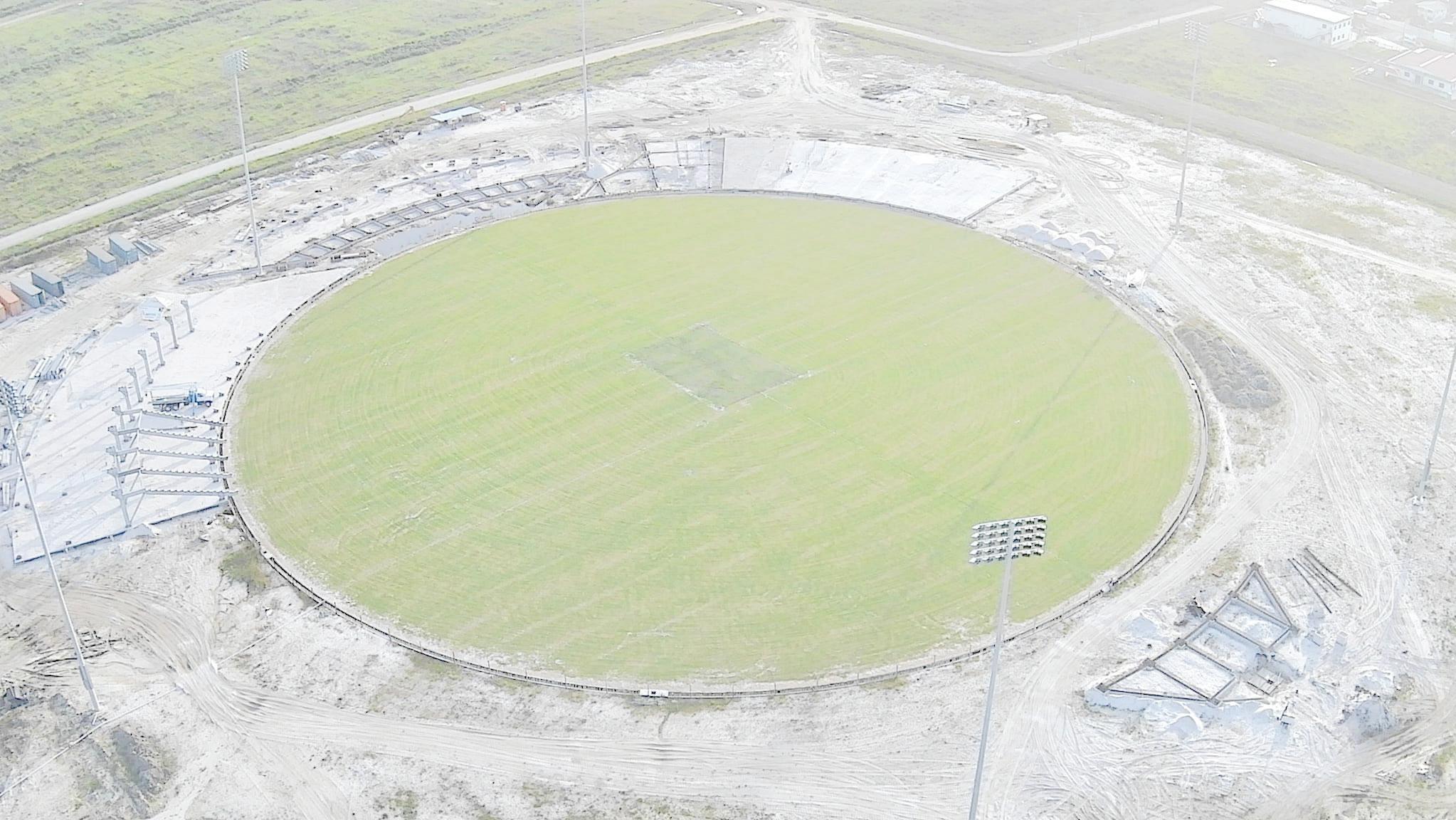








By Shamar Meusa
WITH substantial allocations to cater for the upgrade of Georgetown’s drainage network and the construction of markets, the Ministry of Local Government and Regional Development’s $41.9 billion budgetary allocation for 2025 was approved on Tuesday.
This was done during the 99th sitting of the Twelfth Parliament, during which the Parliamentary Committee of Supply examined the estimates and expenditures for the ministry.
Diving into specific allocations, members of the House asked the Minister
of Local Government and Regional Development
Sonia Parag for details on the $2.725 billion sum, which was specified for the Georgetown enhancement programme.
Against this backdrop, Parag noted that this sum caters for some $2 billion for the upgrades to the drainage network, and further for the construction and rehabilitation of markets in the city.
More specifically, she noted that $40 million has been set aside for the design and supervision, which is the consultancy service for the Bourda Green, while for the construction of Phase One of the Bourda Green, $260
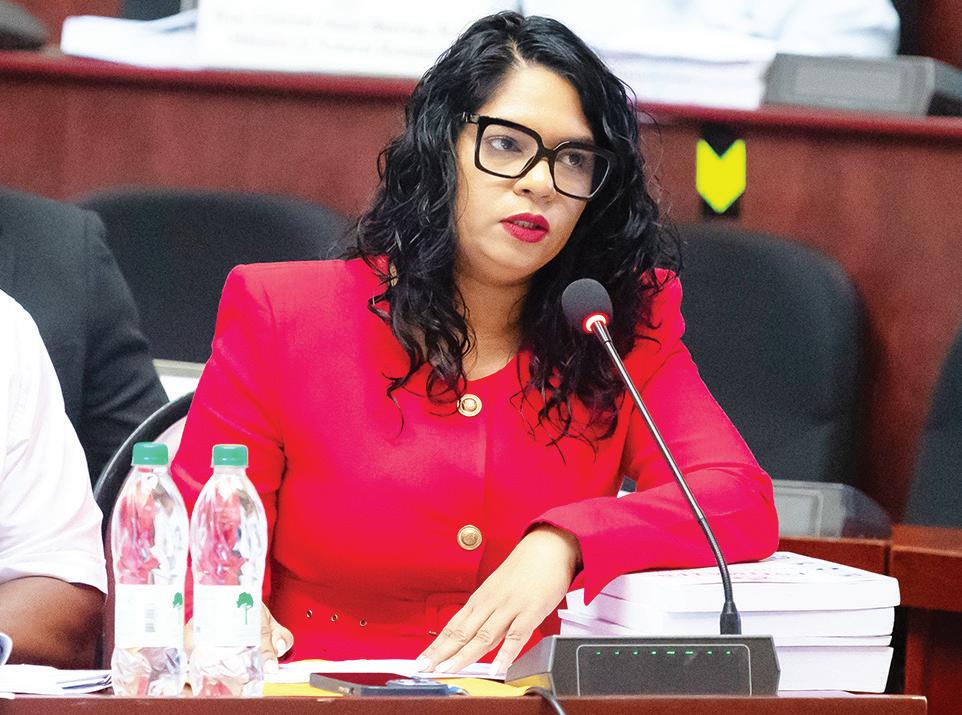
million was set aside.
Giving an explanation, she told the committee that to maximise the space at the Bourda Green, there

Staying on markets, Parag also noted that under a separate $16.5 billion allocation, some $800 million has been set aside for the creation of a “culture market” at Palmyra, Canje, Berbice. This project, she noted, will be the first of its kind here.
were consultations held by the ministry and the Head of State, during which the vendors had indicated that they wanted a ‘proper’ space to utilise for the Bourda Green area.
“Other than the vegetables and greens area, we wanted to see if we can perhaps put at least a two-storey building there to accommodate vendors,” she said.
Minister Parag continued, noting that $50 million was set aside for the rehabilitation of the East Ruimveldt Market, $100 million for the rehabilitation of the La Penitence Market, $75 million for the construction of a green space at the Merriman Mall, and $200 million for the rehabilitation of the Stabroek Market.
Further, under that allocation, sums of monies are set aside for the construction of the Port Kaituma Market, the western section of the Mon Repos Market, the rehabilitation of the market at Unity, Mahaica, the rehabilitation of the Rose Hall Market, the construction of the Bath Market and several others.
Meanwhile, on another important note, sums of money have been set aside for improvements to Guyana’s solid waste management system.
Parag noted that solid waste management has been a burning issue throughout the country, and the government has taken it upon itself to create spaces in terms of landfill sites to accommodate the disposal of garbage from communities.
“So, with the ministry and thankfully the investment of the government and The Ministry of Finance, we are well equipped financially to contribute to this,” she said.
To this end, she revealed that from 2020 to 2024, the government has created some 13 landfill sites across the country, which included ensuring in 2024 that Region Five for the first time has a landfill site, which is located at Blairmont.
The minister noted that they want the programme to be rolled out more robustly this year, and with substantial investments in solid waste management, they also want to be able to create educational awareness on solid waste management in communities.
Added to this, Parag indicated that while they are investing heavily in this programme, new landfill sites will be created in several regions.
“We want to be able to ensure that we also equip the Local Democratic Organs with the capacity to contribute to the collection of garbage, the disposal of garbage, and ensure that we have the educational awareness,” she remarked.
Following intense scrutiny, the Parliamentary Committee of Supply approved the $41.9 billion sum for the Ministry of Local Government and Regional Development.

By Trina Williams
GUYANA’S neighbour, Suriname does not have to stand alone in its development, as, according to President Dr. Irfaan Ali, partnerships and collaboration between the two countries could result in sustainable progress for the region.
With Suriname also establishing itself as a global leader in environmental services like Guyana, President Ali, during a virtual address to the International Business Conference, shared Guyana’s experience as an oil producing nation, and gave advice on how to achieve a resilient economy.
According to the International Monetary Fund (IMF), Suriname’s prospects are bright. President Ali agreed with the organisation's conclusion that the Dutch-speaking nation "stands at the threshold of a transformative era”.
With a buoyant future ahead, President Ali stated: “This will set in train a wave of economic activities that will spawn the expansion of businesses and the generation of jobs, improvements in infrastructure and living standards.”
As he touched on the subject matter of Suriname’s vast natural resources, especially its emerging oil sector, the Guyanese Head of State firmly said that converting the wealth from those resources into improving people’s well-being cannot be overlooked.
“If it is one thing we have learnt from history, it is that wealth alone is not enough to secure resilience and or prosperity. It requires sound management and forward planning, qualities which are possessed by a country’s leadership,” Dr. Ali stated.
Guyana’s oil boom has resulted in a growth surge, and has even positioned the small South American nation as the fastest growing economy in the world.
Guyana’s Gross Domestic Product (GDP) grew by over 60 per cent in 2024, and this was driven by its lucrative oil and gas sector, and investments in infrastructure and social services.
However, Guyana has learnt a few lessons since its first production of oil, President Ali noted. First, he urged Surina-
me to uphold democracy.
He emphasised that political instability could deter investors and attract unwanted elements and economic vultures.
In elaborating on this point, he said: “Democracy, my friends, is not just a form of governance. It is a foundation of stability… Never stray from the democratic path.”
He later pointed out that it is important to understand that democracy also ensures inclusive development, and it is a recipe for long-term stability.
Secondly, he urged Guyana’s neighbour to act early. This means that the window before the economic boom will be key, and it is not a time for complacency or day dreaming. For Pre sident Ali, this is important, especially with the country’s oil production anticipated to surge its growth to 55 per cent in 2028 as predicted by the IMF.
“Let me be frank with you, this will be a significant economic boom, but let me also share with you, it will not happen on its own,” he said while noting that strong and stable leadership, onshore support and infrastructure are needed to
capitalise on the potential opportunities.
Further, investing in people is also crucial, Dr. Ali firmly stated.
“It is not just about infrastructure; it is about the people who will work in the industry,” he said before stressing that education and training must be prioritised now.
Guyana is well experienced when it comes to investing in its people, and there have been a series of initiatives by the government to achieve this, such as the establishment of training institutes.
Additionally, he extended Guyana’s arm and welcomed partnerships between its private sector and Suriname.
He said: “Feel free to work with Guyana’s private sector in coordinating and building partnerships to meet the future requirements of Suriname.”
Third, the President explained the importance of economic diversification, and to solidify his position, he pointed to what occurs in countries that over rely on their oil production.
In Guyana, traditional sectors and industries like bauxite, gold mining, agriculture and forestry have
seen impressive growth.
In fact, Guyana’s nonoil sector has seen more than 40 per cent growth in the last four years, the President said as he called on Suriname to look at its strengths and beyond.
Like Guyana, he said, he thinks Suriname should invest in tourism, technology and renewable energy, as these sectors will ensure the economy remains strong.
Fourth, he encouraged Suriname to use its oil wealth for its future generations, and he later explained the importance of investing in human capital and citizens’ health.
Dr. Ali urged the neighbouring nation to not fall prey to what others are doing or spend excessively, but prioritise saving for the children of the future.
Meanwhile, it was pointed out that prosperity will not come in isolation but rather through partnerships.
President Ali used the opportunity to speak about the optimistic outlook if there is further collaboration.
He said: “Small states like ours must come together, whether as a re -
gional family or through bilateral or multilateral initiatives to avoid economic marginalisation.”
With both Guyana and Suriname not only being bound together by geographic proximity but also their respective wealth of natural resources, the President pointed out a few areas of collaboration.
He said that to ensure there is regional energy security and less dependency on external markets, Guyana, along with Brazil and Suriname will explore the development of an energy corridor.
The Guyanese President said, too, that Guyana is also committed to the goal of energy security for Brazil, Suriname and French Guiana.
Further, he said that both Guyana and Suriname could revolutionise the agriculture sector through collaboration.
Dr. Ali noted, “Imagine a Caribbean where every plate of food is sourced from the fertile soil of Suriname and Guyana.”
He later said: “Suriname’s path to prosperity does not lie in isolation, but in partnerships, collaboration and the vision of a united region.”

–– as President Ali, Vice-President Jagdeo engage landscapers on massive plans
PRESIDENT Dr. Irfaan
Ali and Vice-President Dr. Bharrat Jagdeo on Tuesday engaged in discussions with landscapers in preparation for the advancement of the government’s beautification initiative.
According to information from the Office of the President, the Head of State, in his brief address, said the project will extend beyond Georgetown, and include tree and flower planting in public spaces in com -
munities along the new highways, new schools, and hospitals among other areas.
Over the next five to seven years, the government aims to plant 50,000 flowering and exotic plants and trees along the coast and in the capital city, Georgetown.
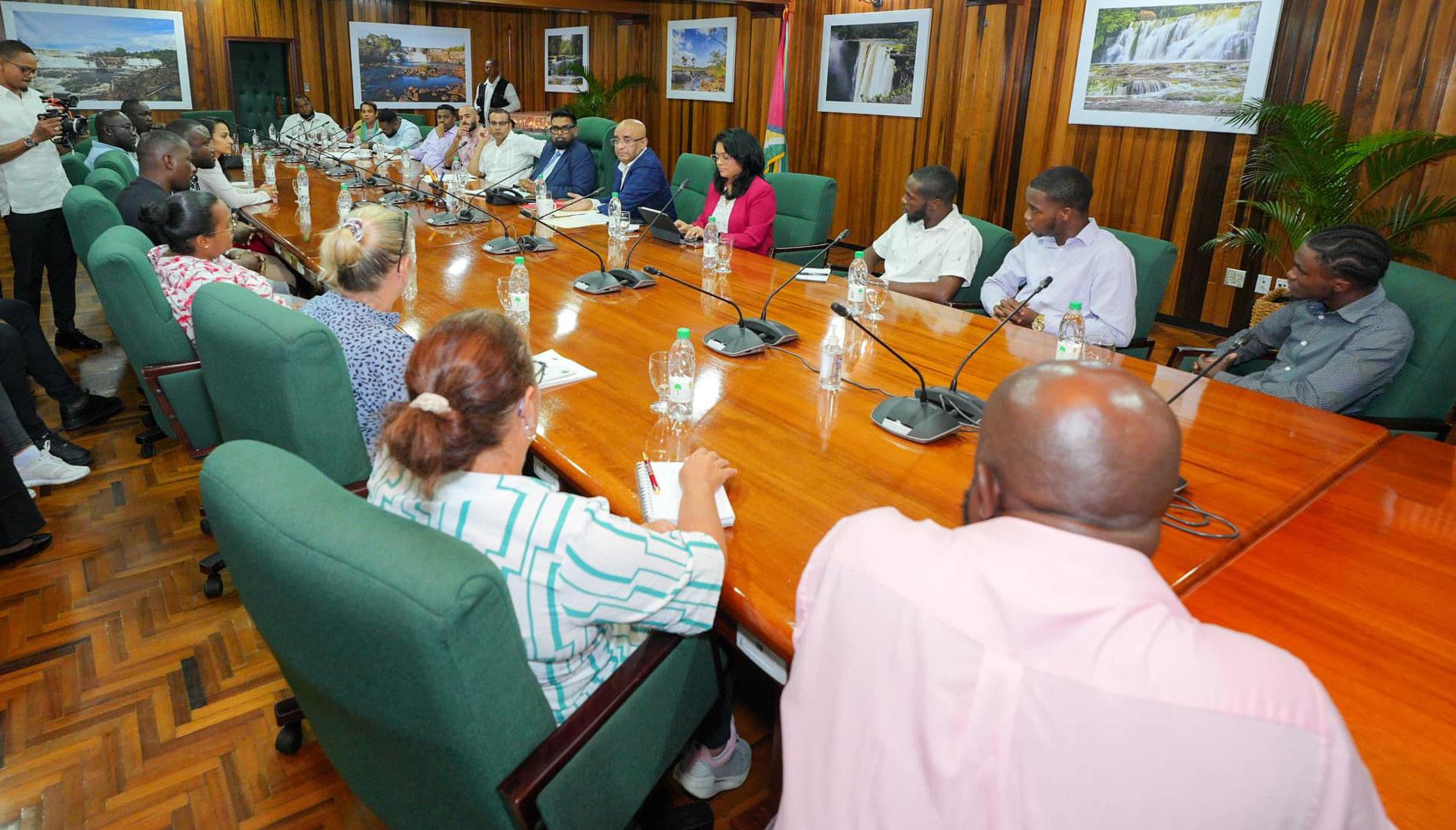

The programme is being rolled out by the Protected Areas Commission in collaboration with several government agencies, including the Guyana Forestry Commission (GFC), the
Ministry of Public Works, and the National Agriculture, Research and Extension Institute (NAREI).
President Ali said the project is part of the country’s cultural heritage.
Foreign Secretary and
Chair of the Protected Areas Commission’s Board Mr. Robert Persaud, and Head of the Protected Areas Commission Mr. Damian Fernandes were also involved in the discussions.
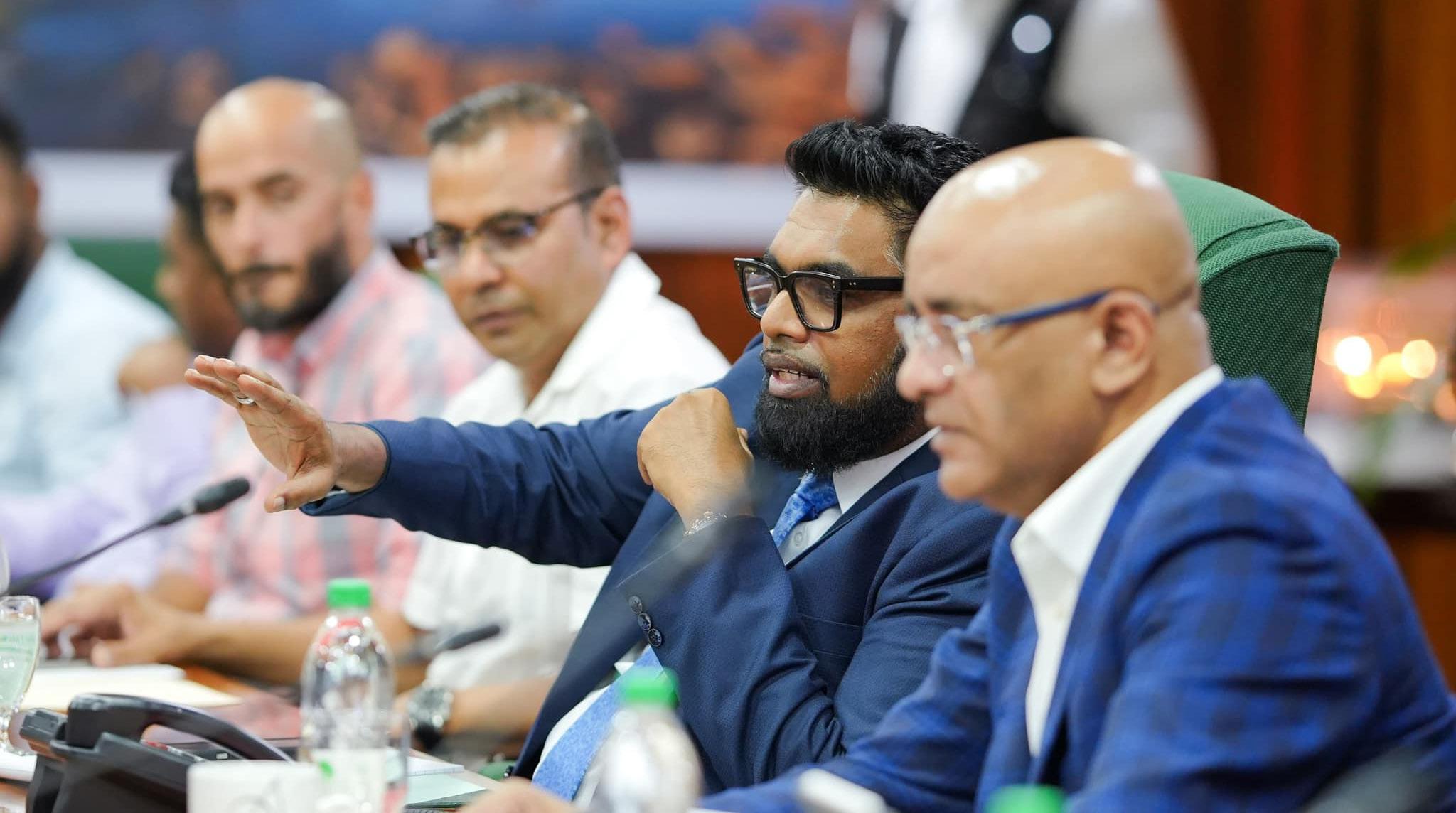


CHANGING patterns of climate variability and extreme weather events are negatively affecting all dimensions of food security, and exacerbating other underlying causes of malnutrition in all its forms in Latin America and the Caribbean, according to the 2024 Regional Overview of Food Security and Nutrition.
The report, published recently, states that Latin America and the Caribbean is the second-most exposed region in the world to extreme weather events, following Asia.
In this region, at least 20 countries (74 per cent of analysed countries) face a high frequency of such events, indicating significant exposure, and 14 (52 per cent) are considered vulnerable, as they are more likely to experience increased undernourishment due to these phenomena.
The impact of extreme weather events is further worsened by persistent structural challenges, including conflicts, economic slowdowns, crises, and underlying factors such as high levels of inequality, lack of access to affordable healthy diets, and unhealthy food environments.
According to the report, between 2019 and 2023, the prevalence of undernourishment increased by 1.5 percentage points in countries affected by climate variability and extremes. The situation is worse in countries experiencing economic recessions. The most vulnerable populations are disproportionately affected, as they have fewer resources to adapt.
The report underscores
the urgent need to accelerate action to build resilience within agri-food systems, which are critical for the region’s progress towards eradicating hunger and malnutrition in all its forms.
The report emphasises that ensuring the longterm sustainability of agrifood systems is essential.
According to the report, hunger affected 41 million people in the region in 2023
This represents a decrease of 2.9 million people compared to 2022, and 4.3 million compared to 2021. However, despite regional progress, disparities persist among subregions. Hunger prevalence has increased over the last two years in the Caribbean, reaching 17.2 per cent, while it has remained relatively stable in Mesoamerica at 5.8 per cent.
Regarding moderate or severe food insecurity, the region also showed progress for the second consecutive year, falling below the world average for the first time in 10 years. A total of 187.6 million people in the region experienced food insecurity, 19.7 million fewer than in 2022, and 37.3 million fewer than in 2021.
This reduction is attributed to the economic recovery of several South American countries, driven by social protection programmes, post-pandemic economic efforts, and targeted policies to improve food access.
The report also high -
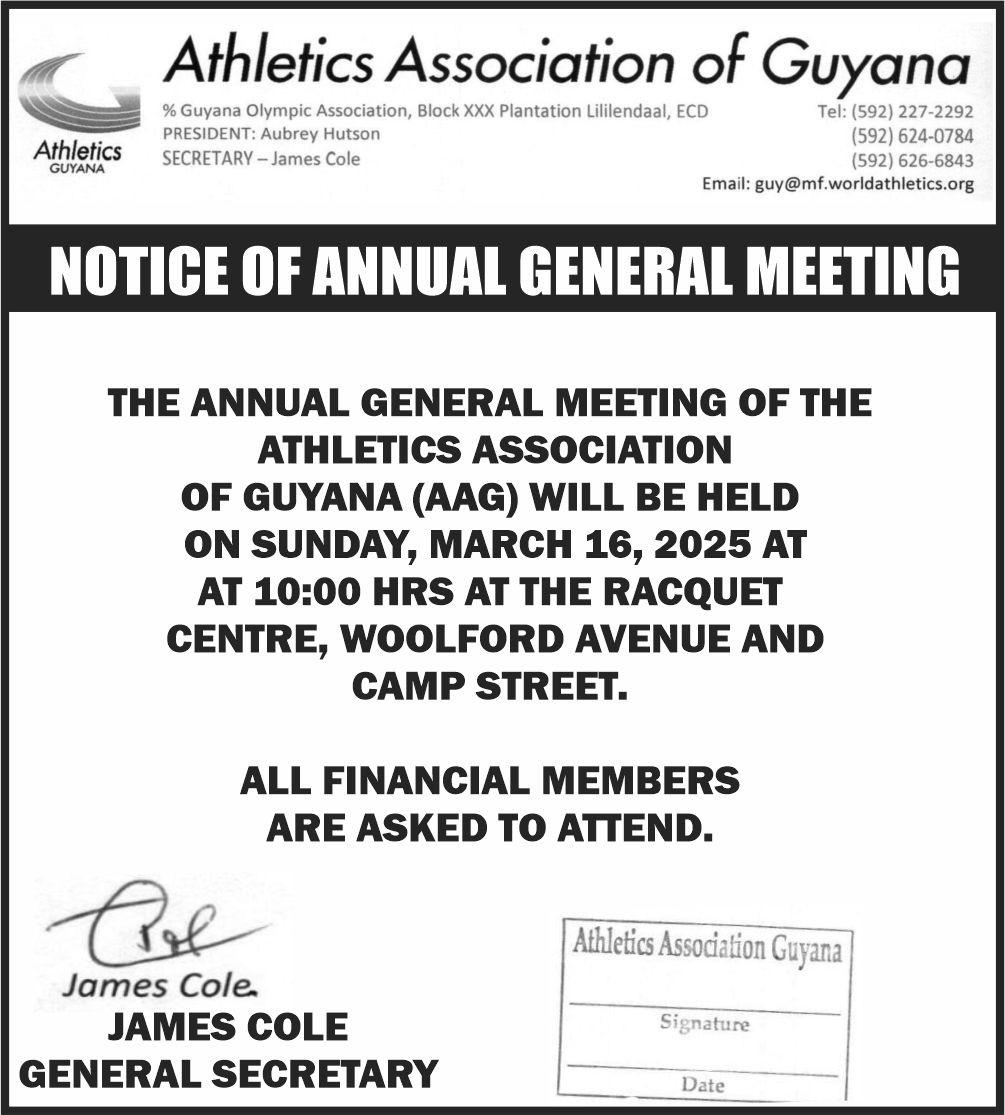
lights that food insecurity disproportionately affects certain population groups, such as rural communities and women.
The gender gap in Latin America and the Caribbean remains higher than the global average.
THE CHALLENGE OF MALNUTRITION AMID CLIMATE VARIABILITY
FAO Assistant Director-General and Regional Representative for Latin America and the Caribbean Mario Lubetkin highlighted the relevance of the Regional Overview 2024 considering that: “Climate variability and extremes are a threat for the stability of food security and nutrition.”
He added: “The importance of implementing a comprehensive response, based on policies and actions, is designed to strengthen the capacity of agri-food systems. This resilience allows us to anticipate, prevent, absorb, adapt, and transform in a positive, efficient and effective way against various risks, including the challenges associated with climate change and extreme events.”
Regarding malnutrition, the report states that in 2022, stunting affected 22.3 per cent of children under five globally. In Latin America and the Caribbean, the prevalence was estimated at 11.5 per cent, significantly below the global average. While the region has made notable progress since the turn of the millennium, progress has slowed in recent years.
“In Latin America and the Caribbean, one in ten children under five lives
with stunting. Undernourishment and overweight coexist in the region, exacerbated by high exposure and vulnerability to climate events in the most affected communities. This double burden of malnutrition daily threatens the full development of children,” said Karin Hulshof, UNICEF Regional Director a.i. for Latin America and the Caribbean. “Any decision on climate action must prioritise the right to food and nutrition for children, women, and families.”
In 2022, 5.6 per cent of children under five globally were overweight, compared to 8.6 per cent in Latin America and the Caribbean, 3.0 percentage points above the global estimate. The regional prevalence has also grown faster than the global rate, increasing by 1.2 percentage points between 2012 and 2022, compared to only 0.1 percentage points globally. The region’s trends vary significantly, with South America mainly driving the increase, while Mesoamerica and the Caribbean have shown greater stability in recent years.
The report also identifies economic barriers to accessing healthy diets as a critical issue. In 2022, 182.9 million people in Latin America and the Caribbean could not afford a healthy diet. This marks an improvement of 2.4 percentage points compared to 2021, meaning 14.3 million more people can now afford a healthy diet.
“Overweight and obesity are growing challenges in the region, and key risk factors for non-communicable diseases. A healthy diet is the foundation for health, well-being, and optimal
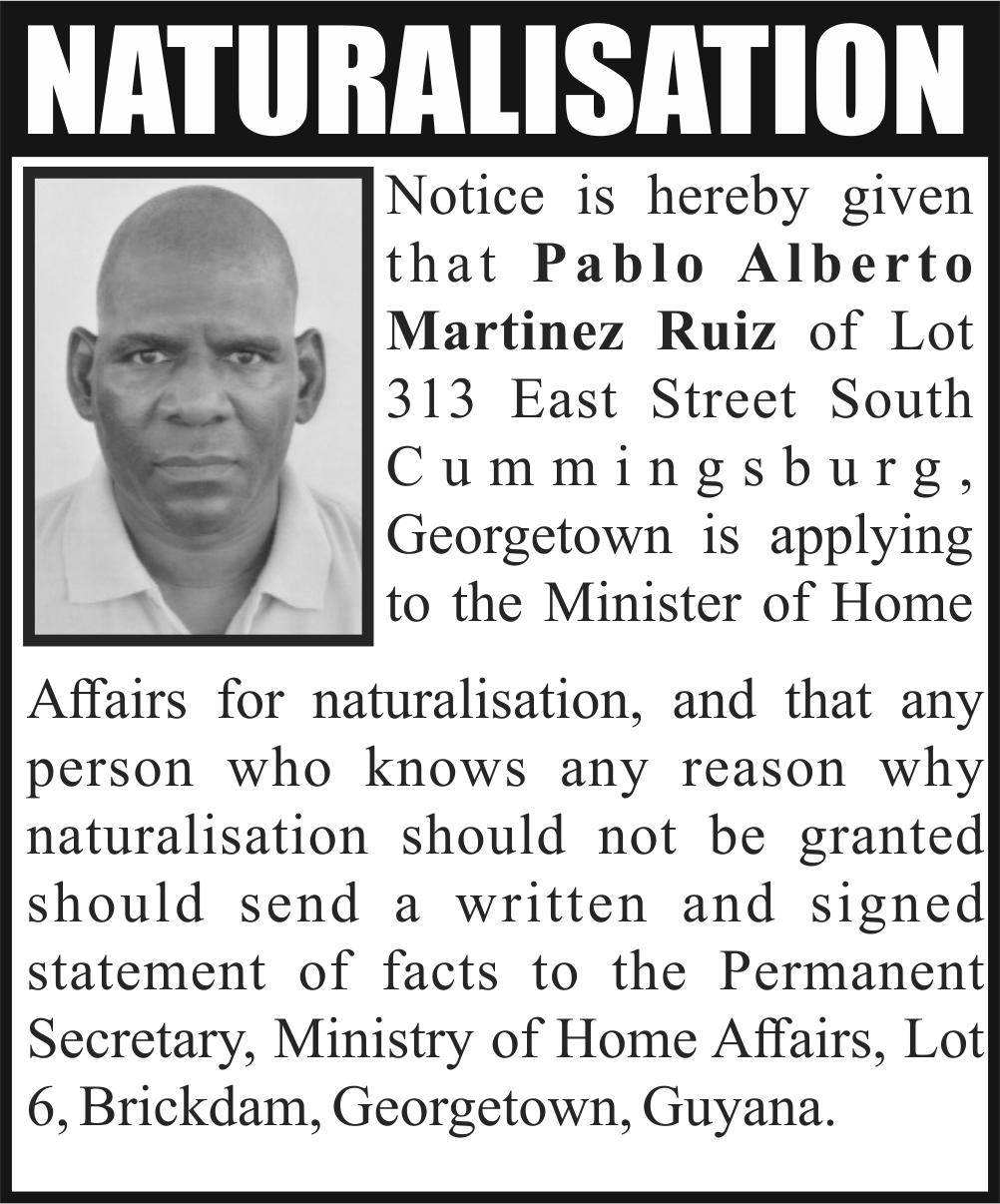
growth and development.
PAHO positions health as a cornerstone for transforming food systems, promoting fiscal policies such as taxes, public food procurement policies, regulations on advertising (including breast milk substitutes), food safety, product reformulation, and front-of-pack labeling,” said Jarbas Barbosa, Director of the Pan American Health Organisation.
Disparities also persist among subregions in access to healthy diets. In the Caribbean, 50 per cent of the population (22.2 million people) could not afford a healthy diet, followed by Mesoamerica at 26.3 per cent (47.1 million people), and South America at 26 per cent (113.6 million people). This highlights the need to focus on vulnerable populations exposed to extreme climate events.
“Climate shocks are making it increasingly difficult for families across Latin America and the Caribbean to produce, transport, and access food. Frequent storms and floods are destroying homes and farmland, while drought and erratic rainfall are wiping out crops before they can grow,” said Lola Castro, WFP’s Regional Director for Latin America and the Caribbean. “As extreme weather events intensify, WFP is working with communities and governments to strengthen food security, protect the most vulnerable and build resilient food systems that can withstand the climate crisis”, she added.
The agencies emphasised the need to further accelerate investments and actions to create long-term capacities to address climate variability and extreme
–– new UN report shows
weather events.
Rossana Polastri, Regional Director for Latin America and the Caribbean at IFAD, stated: “We are making progress in the fight against hunger, but the numbers still exceed pre-pandemic levels, showing there is much work to be done. We must redouble efforts to adapt food systems to the effects of climate change, whose negative impacts exacerbate food insecurity.
“To achieve this, we need to invest more in rural areas, ensuring that smallscale producers have access to basic infrastructure, climate information systems, sustainable agricultural practices, and financial products to cope with extreme events and climate variability.
“Additionally, we must invest in women and the most vulnerable groups to ensure that progress in reducing hunger leaves no one behind.”
“The 2024 Regional Overview of Food Security and Nutrition is a joint publication by the Food and Agriculture Organization of the United Nations (FAO), the International Fund for Agricultural Development (IFAD), the Pan American Health Organisation/ World Health Organisation (PAHO/WHO), the World Food Programme (WFP), and the United Nations Children’s Fund (UNICEF). (FAO)



THE 2022 oil and gas licensing round in Guyana is almost completed, with four PSAs scheduled for completion in 2025, a milestone in responsible resource management.
The government has attracted prestigious international players such as TotalEnergies, Qatar Energy, and Petronas, and sets a high standard in the equitable development of resources for the oil-producing economy by committing to transparency and competi -
tive bidding, publicly disclosing fiscal terms, technical requirements, and model PSAs.
Guyana has also responded to skepticism about the opacity of its processes through transparency with bidders and adherence to international best practices.
The award of blocks S4, S5, S7, and S10 underlines a strategic balance in leveraging global expertise and fostering local partnerships.
For instance, the
awards to International Group Investment Inc. show that Guyanese entities can meaningfully participate in the sector as expected by the broader objectives of the local content policy.
Confidence in Guyana's regulatory regime, for example, is indicated by the selection of major companies such as TotalEnergies, an improved regime through industry expert consultations, and comparisons against various international models. This
will ensure that the nation's 11 billion barrels of recoverable resources translate into sustained economic growth, and not just short-term gains. Critics might say that such rapid expansion comes with environmental or social trade-offs, but Guyana's simultaneous push for gas monetisation and regional collaboration with Suriname reflects a forward-thinking strategy.
Projects like the Gas-to-Energy initia -
tive, poised to halve energy costs, demonstrate how hydrocarbon revenues are being channeled into transformative infrastructure. Moreover, the government's vigilance against "fronting", and its emphasis on equitable benefit-sharing reinforce a governance model that puts national interest over corporate profiteering.
As Guyana moves to finalise these PSAs, the real challenge will lie in sustaining the momen-
tum. Ensuring that terms of contract align with long-term development goals, and that civil society stays engaged will be crucial.
For now, the licensing round stands as a testament to what transparent, inclusive resource governance can achieve: Attracting investment while safeguarding sovereignty. The world is watching, and Guyana is proving that even small nations can set global be nchmarks.
Dear Editor,
I HAVE noted that the opposition parties are at it again. They are questioning the accuracy of the voters list and threatening to be their usual destructive selves. In the process, they are relying on downright lies, distortion and halftruths.
It is true that the voters list is somewhat large. However, from the time the decision was taken to move towards continuous registration, a decision that the opposition was fully on board with, it was known that this situation would have arisen.
The reason was to avoid having to do a completely new list at every
election. Moreover, it was realised that if a no-confidence motion was passed unless we have continuous registration, we would not be in a position to hold elections in three months, as the Constitution requires.
The PNC and others who were in the opposition at that time were very keen on this. They supported it wholeheartedly. Moreover, if for any reason we needed an urgent referendum, the old system of registration could not suffice.
The main question here must be that all the names on the list are real persons and not fictitious. Many measures have been put in place, at great cost,

we should note, to ensure that that was so.
For instance, whenever a person is registered, GECOM officials along with representatives of the ruling and opposition parties visit the home of the registrants to ensure that all the information is correct. It is then signed off by a GECOM official and the representatives of the political parties. The other issue is the question of biometrics. When talk of this arises, the opposition deliberately choose to ignore the fact that every registrant is fingerprinted. Before elections are held, the whole database is sent abroad, to reputable companies in either the US
or Canada, accompanied by officials of GECOM and representative of the political parties, to be checked for any duplicate registrants.
This guarantees that a voter is only registered once.
This system has been working very well and was tested on more than one occasion.
In 1997, the elections were forensically audited by a team of competent CARICOM elections specialists headed by Mr. Ulric Cross of Trinidad and Tobago. In the final report, it was stated that not a single fraudulent vote was found.
In 2001, the Chairman of GECOM, Mr. Joseph
Singh, Major General (Ret’d.) invited international elections specialists to audit the elections before he demitted office. Again, not a single fraudulent vote was found.
It’s because it is so difficult to rig the elections that the PNC/APNU/AFC tried to do so from inside. From all appearance, they succeeded in 2015 but were caught in 2020.
In relation to dead people being on the list, it seems very unlikely or at best very minimal since the list of dead persons is sent over monthly from the Births and Deaths Department so that those names are removed from the list.
The fundamental
points should not be lost in the PNC/APNU/AFC offensive and attempts at sowing confusion, that is, firstly all the names on the list are real people, some may be abroad temporarily (maybe President Trump’s deportation policy would help to ensure that they return). The second fact is that a person can only vote once. The opposition would be better served if they play a positive role in nation building in whatever capacity they are operating instead of attempting to disrupt.
That would be the patriotic thing to do.
Yours truly, Donald Ramotar, Former President

Dear Editor,
AS we approach the General and Regional Elections later this year, the PNCR/APNU/ AFC is once again presenting themselves before the Guyanese people with grand promises, hoping to erase the painful memories of their most recent tenure from 2015 to 2020. Their record stands as irrefutable proof of incompetence, mismanagement, and blatant disregard for the well-being of Guyanese citizens.
Guyanese should not forget how this nation was hoodwinked by the PNCR/APNU/ AFC with hollow promises of prosperity, development and a brighter future leading to the 2015 General and Regional Elections.
However, once they got hold of power, our citizens were placed in an economic and social stranglehold with the imposition of draconian economic measures and wasteful spending, which plunged our country and its citizens into deep poverty while their friends and cronies were the only ones living the “Good Life” David Granger promised.
Readers will recall that at the onset of their tenure, the PNCR-led coalition wasted no time in imposing, on the backs of the Guyanese people, over 200 new and increased burdensome taxes and fees. The Granger Administration placed VAT on essential goods and services, including water, electricity, data, medical services, private education, agriculture and mining equipment, introduced a new environmental tax, and increased several fees and licenses – a move that hurt small enterprises – not even the huckster and donkey cart man was not spared. Vehicle import duties surged, while the implementation of draconian mining and forestry regulations crippled these industries.
Despite their promises of revitalising the sugar indus-
try, they closed the Skeldon, Rose Hall, Enmore, and Wales estates, resulting in over 7,000 sugar workers losing their jobs and devastating thousands of families. Their mismanagement of the oil and gas sector led to a highly criticised, lopsided contract, leaving Guyana with a mere two per cent royalty. Lest we forget the story behind the US$18M signing bonus, which Winston Jordan claimed was a ‘gift’.
Unemployment skyrocketed due to poor governance in key sectors such as agriculture and mining, causing these sectors to collapse. Construction was ground to a halt, local and foreign investment reached a standstill, and the economic burden on Guyanese soared to new heights. Incompetent economic management and these burdensome measures resulted in a job loss estimated to have exceeded 40,000. Our nation was one without hope.
To rub salt in the wound, the PNCR/APNU/AFC squandered billions of dollars on failed projects riddled with corruption, including the D’Urban Park Project, where millions of taxpayers’ funds went unaccounted for, and the Sussex Street bond rental scandal, where the government paid over $14 million per month for an inadequate facility. Cronies and other members of the PNC/APNU/ AFC ‘friends and family’ clique stole billions of taxpayer dollars through a host of corrupt deals such as single-sourcing of overpriced drugs which were never delivered in many cases, land giveaways, etc.
Additional corruption scandals included procurement fraud in the then Ministry of Public Health, where contracts were awarded to unqualified companies and the mismanagement of funds allocated for school feeding programmes. The APNU/ AFC also engaged in dubious transactions involving state
lands, selling prime real estate at undervalued prices to financiers and their cronies. Under the coalition, Ministers were either diverting government businesses to their private companies or collecting gold bangles. Under the PNCR/ APNU/AFC, corruption and mismanagement were at their highest in post-independent Guyana.
One would have expected that the successful No-Confidence Motion on December 21, 2018, would have halted the deep-rooted corruption and opened the eyes of the PNCR/APNU/AFC. But they had no regard for our Constitution and illegally held onto power until 2020, plunging our nation into political instability. During this period, the Granger Administration splurged hundreds of millions of state funds without the approval of the National Assembly. Their attempt to rig the 2020 elections, including inflating numbers in Region Four’s declaration and defying court orders, obstructed transparency and delayed democracy for five months until they were removed from office in August 2020.
During their tenure, healthcare services deteriorated due to underinvestment, leading to medicine shortages, poorly maintained facilities, and corrupt procurement practices. Infrastructure development was neglected, with major roads and bridges falling into disrepair. Hinterland and Indigenous communities suffered as Amerindian Development Funds were slashed, crucial projects abandoned, and land titling initiatives discontinued. Crime rates escalated due to inadequate investment in law enforcement and demoralisation of the Guyana Police Force.
Internationally, Guyana’s diplomatic standing weakened, with strained relations within CARICOM and other global partners further exacer-
bated by their electoral fraud attempts in 2020. Their handling of the Venezuela border controversy was lackluster, failing to mount a strong diplomatic defence of Essequibo.
In stark contrast, the People’s Progressive Party/Civic (PPP/C), under the visionary leadership of President Dr. Irfaan Ali, has spearheaded an era of unprecedented transformation since taking office in August 2020. The PPP/C Government has made remarkable progress in transforming Guyana’s economy, infrastructure, social development, and governance.
Since assuming office, the PPP/C has overseen rapid economic growth, making Guyana the fastest-growing economy globally, with double-digit GDP growth annually. They have expanded oil and gas production, successfully auctioned new oil blocks, and implemented the Local Content Act to ensure Guyanese benefit from the sector. Diversification efforts have attracted major investments in agriculture, tourism, manufacturing, and ICT, reducing overdependence on oil. Foreign Direct Investment has surged, with billions secured for hotels, manufacturing, and infrastructure projects. Stable macroeconomic policies have helped lower inflation rates, maintained a stable exchange rate, and support small businesses through grants and low-interest loans. Infrastructure development has been a priority, with significant projects such as the new Demerara River Bridge, expansions of the East Bank, East Coast, and West Coast highways, and the construction of four-lane highways in key areas. The Berbice Deepwater Port project has commenced, boosting trade and connectivity.
The Cheddi Jagan International Airport (CJIA) has been expanded, and over 40,000 house lots have been distributed nationwide. Additional-
ly, the PPP/C has launched transformative projects like the Linden to Mabura Hill Road, enhancing connectivity between the hinterland and coastal regions, and invested heavily in modern drainage and irrigation systems to mitigate flooding and support agriculture.
The Wales Gas-to-Energy Project aims to slash electricity costs by 50 per cent, complemented by renewable energy initiatives, including solar farms and hydropower projects. The government has implemented salary increases and tax relief measures and reversed VAT on essential items. The “Because We Care” Grant has been reinstated and increased, and pension and public assistance programmes have expanded. The PPP/C has also introduced comprehensive social welfare programmes, including enhanced disability support, youth employment initiatives, and women’s empowerment programmes. Healthcare has improved with new hospitals, expanded specialty medical services, and free dialysis treatment. The government has also upgraded primary healthcare facilities, introduced telemedicine services in remote areas, and improved the supply chain for critical medicines. Education reforms include free University of Guyana tuition by 2025, modern secondary schools, smart classrooms, and expanded TVET centres. Scholarships for tertiary education have increased, and literacy programmes have been revitalised to support lifelong learning. Agriculture has received significant investments, with reopened sugar estates and expanded aquaculture and livestock industries.
The PPP/C’s focus on sustainable agriculture has positioned Guyana as the agricultural hub of CARICOM, with innovations in climate-resilient farming and agro-processing industries
that create jobs and boost exports. The security sector has been modernised with better-equipped police stations, new crime-fighting technologies, and judicial reforms. E-governance initiatives have digitised public services, and international relations have strengthened with the successful defence of Guyana’s sovereignty against Venezuela at the ICJ. The PPP/C’s proactive foreign policy has secured strategic partnerships and development assistance, enhancing Guyana’s global standing.
Unlike the PNCR/APNU/ AFC, the PPP/C actively engages with citizens, addressing concerns and implementing policies that improve lives. As we approach the 2025 elections, I urge Guyanese not to lose sight of the sordid record of the coalition between 2015 and 2020 and the pain this nation suffered under the uncaring and self-interest bunch in the PNCR/APNU/AFC. They will come to you in different forms and under different names, hoping they can once again hoodwink voters into believing they have reformed and now have all the answers to be the next government. The reality is they are incompetent, corrupt and untrustworthy and should be kept very far away from the seat of government.
On the flip side, the party with a proven track record of delivering for the people, honouring its promises and delivering real development for all Guyanese regardless of their geographic location or political persuasion is the People’s Progressive Party/Civic. Our country is flourishing like never before. Let us not gamble with our future; let’s vote wisely and stay the course of unprecedented development by voting solidly for the PPP/C.
Sincerely, Eddy Layne
THE persons listed below (please remember their names) are Guyanese, some living in Guyana, some who have been out of Guyana for a long time now, who wrote a letter on November 17, 2022 in the Stabroek News requesting that Guyana get out of oil production immediately.
The letter was initially sent to President Ali on November 11, 2022 and was titled; “A fair deal for Guyana, a fair deal for the planet.”
I quote from the letter: “We are deeply concerned that the Government’s policy to pursue economic development based on oil and gas is bad for Guyana. Oil and gas production are an existential threat to Guyana.
“We cannot support government’s policy to produce oil and gas when every ton of greenhouse gas pollution helps to destroy our original ancestral home and cause loss of life in African countries. We call for a national moratorium on all petroleum operations in Guyana – offshore and onshore.
“This is to allow for us Guyanese, the owners and beneficiaries of all the oil and gas resources which are our patrimony, to collectively pause so as to take stock of the oil and gas situation, scientifically, fact-check the cumulative environmental and human impacts of oil and gas on our country.”
Here are the names:
Vanda Radzik, Alissa Trotz, Vidyaratha Kissoon, Karen de Souza, Pauline
Melville, Christine Samwaroo, Danuta Radzik, Maya Trotz, Susan Collymore, Joy Marcus, Halima Khan, Vanessa Ross, Wintress White, Gary Girdhari, Nicole Cole, Abbyssinian Carto, Nigel Westmaas, Joan McDonald, Duane de Freitas, Akola Thompson, Joan Cambridge, Immaculata Casimero, Terry Roopnaraine, Colin Klautky, Earl John, Janette Bulkan, Sandy de Freitas, Sherlina Nageer, Jocelyn Dow, Elizabeth Deane-Hughes, Mosa Telford, Suraiya Ismail, Leila Jagdeo, Gerald Perreira, Romario Hastings, Paulette Allicock, Daniel Allicock, Isabelle de Caires, Luke Daniels, Red Thread, Amerindian Peoples Association, South Rupununi District Council, The Breadfruit Collective, Makushi Research Unit.
Of those names listed above, here is the foreign status of those who want Guyana to get out of oil:
1 – Dr. Janet Bulkan serves the University of British Columbia.
2- Dr. Alissa Trotz serves the University of Toronto
3- Dr. Nigel Westmass serves Hamilton College in New York
4- Dr. Maya Trots serves the University of South Florida
5 - Isabelle DeCaires lives in her homeland of the UK where her son plays cricket in the county championship for Middlesex.
6 – Abyssinian Carto is of Rastafari orientation and lives in New York.
7 -- Dr. Cary Gildarie lives in New York.
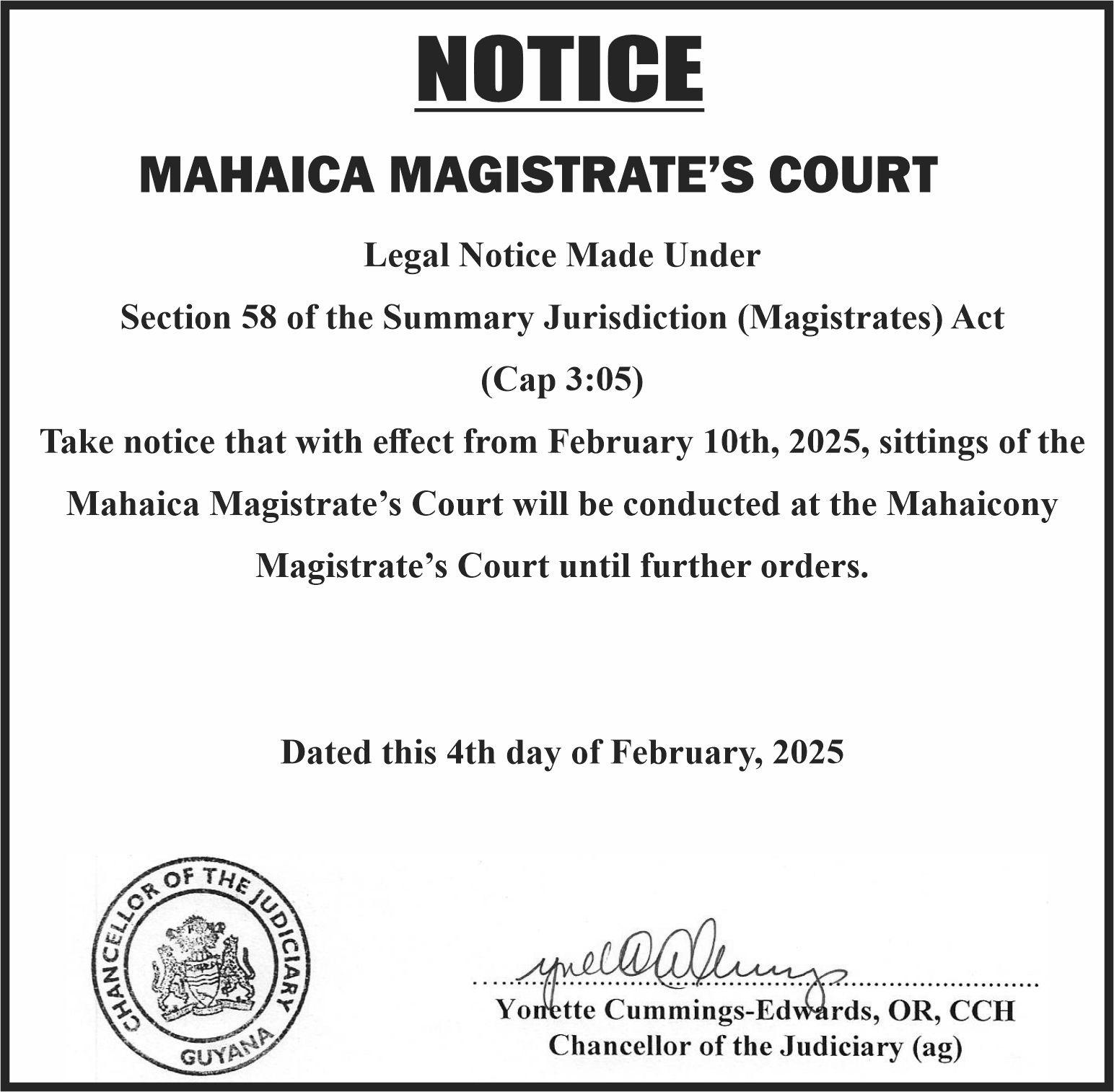

8 – Terry Roopnaraine lives in his homeland of the UK.
9 – Pauline Melville moved to the UK since the early 1950s.
10 – Christina Samaroo moved to New York in 2008
11 – Luke Daniels lives in the UK
I did not elaborate the time these people left Guyana. In a majority of cases, their foreign existence is between 15 and 45 years. Imagine you left Guyana 25 years and you want to decide for us who live here? There are two others who want Guyana to leave the oil in the ground that are not listed a signatories to the letter sent to President Ali.
One is Professor Percy Hintzen. He worked for 30 years at the University of California at Berkley where he retired but instead of coming home went on to live in Florida. The other one is Andre Brandli who never visited Guyana and works in Germany.
An important note: Mr. Gerald Perreira, whose name appears as a signatory, has withdrawn his name. Mr. Perreira is the leader of the small political party, “Organization For The Victory Of The People” and one of the longest serving Pan-Africanists in the Caribbean.
Mr. Perreira told me he does not agree with the position on oil by these “middle
class folks” (his words) and regret signing the letter. Mr. Perreira related to me how his name came to be associated with the letter. Readers would not believe the deception that was used.
So in 2025 with the policy of President Trump to intensify oil drilling, where are these anti-oil Guyanese? They have the temerity to speak for the Guyanese people so why don’t they arrogate to themselves as they did with us, here in Guyana, the right to speak for the American people.
They live in the US where the fossil fuel industry will be expanded, so why don’t they tell Guyanese how they feel about the new American policy through a letter either in an American newspaper or in one of the four dailies in Guyana. The US Government at the beginning of 2025 pulled out of the Paris Climate Agreement.
Will they write about that? Will Dr. Alissa Trotz tell us about that in her niche at Stabroek News titled “In The Diapora?” I hope so!
DISCLAIMER: The views and opinions expressed in this column are solely those of the author and do not necessarily reflect the official policy or position of the Guyana National Newspapers Limited.

WITHOUT substantive backings, the bold promises of the PNCR-led opposition risk creating economic chaos and eroding public trust, financial expert Rennie Parris has contended.
In his column “Talking Dollars and Making Sense,” Parris highlighted that the proposed fiscal policies of the opposition would deplete all of Guyana’s oil revenues within a year.
“More concerning, these policies –when combined with existing spending priorities for various government ministries and programmes – would deplete the entire Natural Resource Fund (NRF) within a year,” he wrote in his latest column which examined the lofty promises made by the PNCR-led opposition.
Among those promises are: monthly cash grants of $100,000 to $150,000 to every adult Guyanese; $400,000 per month tax threshold; $100,000 per month old age pension; and 35 per cent salary increases among other measures.
The financial expert said that even if the opposition saves $300 billion through capital expenditure reallocation, reduces corruption, and improves government efficiency, the combined costs of proposed cash grants, tax relief, and pension increases would still result in a deficit.
He explained that the NRF’s current balance of $646 billion, proceeds from oil, royalties, investment income, government taxes and non-taxed revenue, carbon credits, and the Guyana REDD+ Investment Fund are projected to provide the government with $1.7 trillion in spending power in 2025.
However, the $900 billion PNCR cash-grant policy would reduce that amount to $800 billion. Additionally, the $45 billion reduction in tax revenue due to raising the tax threshold and the $55 billion increase in spending from higher pensions would leave the government with $700 billion – a figure that must fund the entire government, including ministries, loan servicing and new PNCR initiatives like rent, mortgage, and utility subsidies, childcare assistance, and a 35 per cent salary increase.
“By the end of 2025, there would be no money left in the NRF,” he stated.
To make matters worse, Parris explained that if oil prices drop to an average of $50 per barrel – a real possibility given the volatility of global energy markets – Guyana’s oil revenue could shrink by up to $185 billion.
He said that this would force the government to choose between massive


spending cuts or taking on more debt, further increasing the deficit.
As such, he said that the proposed measures are deeply concerning and risk creating economic chaos.
“While the PNCR’s proposals may resonate with voters at first glance, their lack of a sustainable framework is deeply concerning. Policies must be grounded in fiscal realism and designed to promote inclusive growth. Bold promises without substantive backing risk creating economic chaos and erod-
ing public trust,” the expert stated. Parris’ academic credentials include a Bachelor’s in Finance and a Master’s in Real Estate from Baruch College, complemented by an MBA in Strategic Management from The Wharton School at the University of Pennsylvania. He holds the prestigious Chartered Financial Analyst (CFA) designation, recognised globally as the highest qualification in the finance industry. His 18-year career spans some of the world’s leading financial institutions.
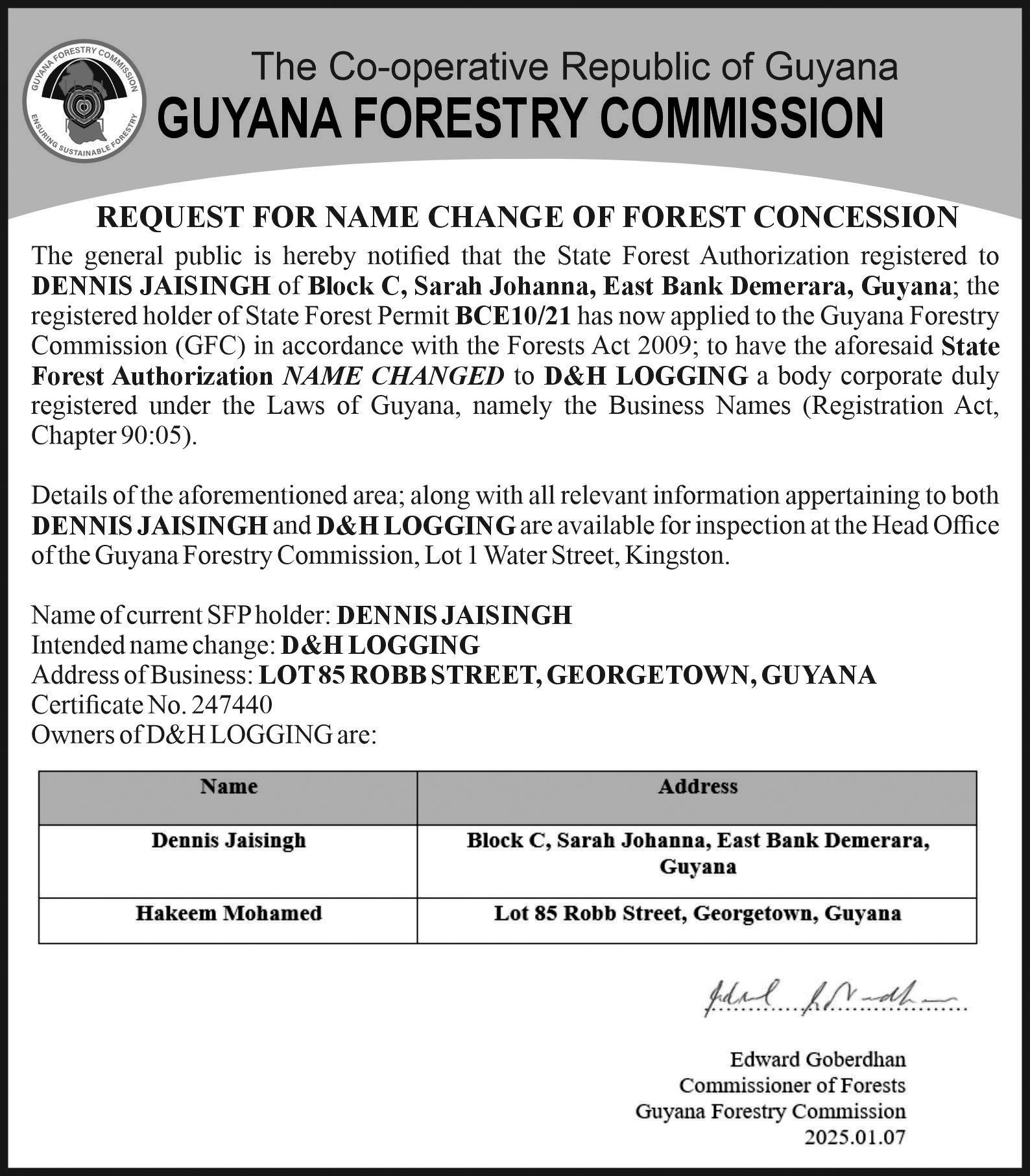
AGRICULTURE Min-
ister Zulfikar Mustapha on Tuesday handed over a brand new mini excavator to officials from the Industry/Plaisance Neighbourhood Democratic Council (NDC).
According to information from the Ministry of Agriculture, while engag-
ing residents, Mustapha said he recently spoke with President Dr. Irfaan Ali and Vice-President Dr. Bharrat Jagdeo, who both advised that the local democratic organ be supported with an excavator to assist with maintaining the internal drainage and irrigation system.
Minister Mustapha also said that over the years, the government has been working to develop a comprehensive drainage system for the country.
“While we are doing large projects and constructing high-level canals and pump stations
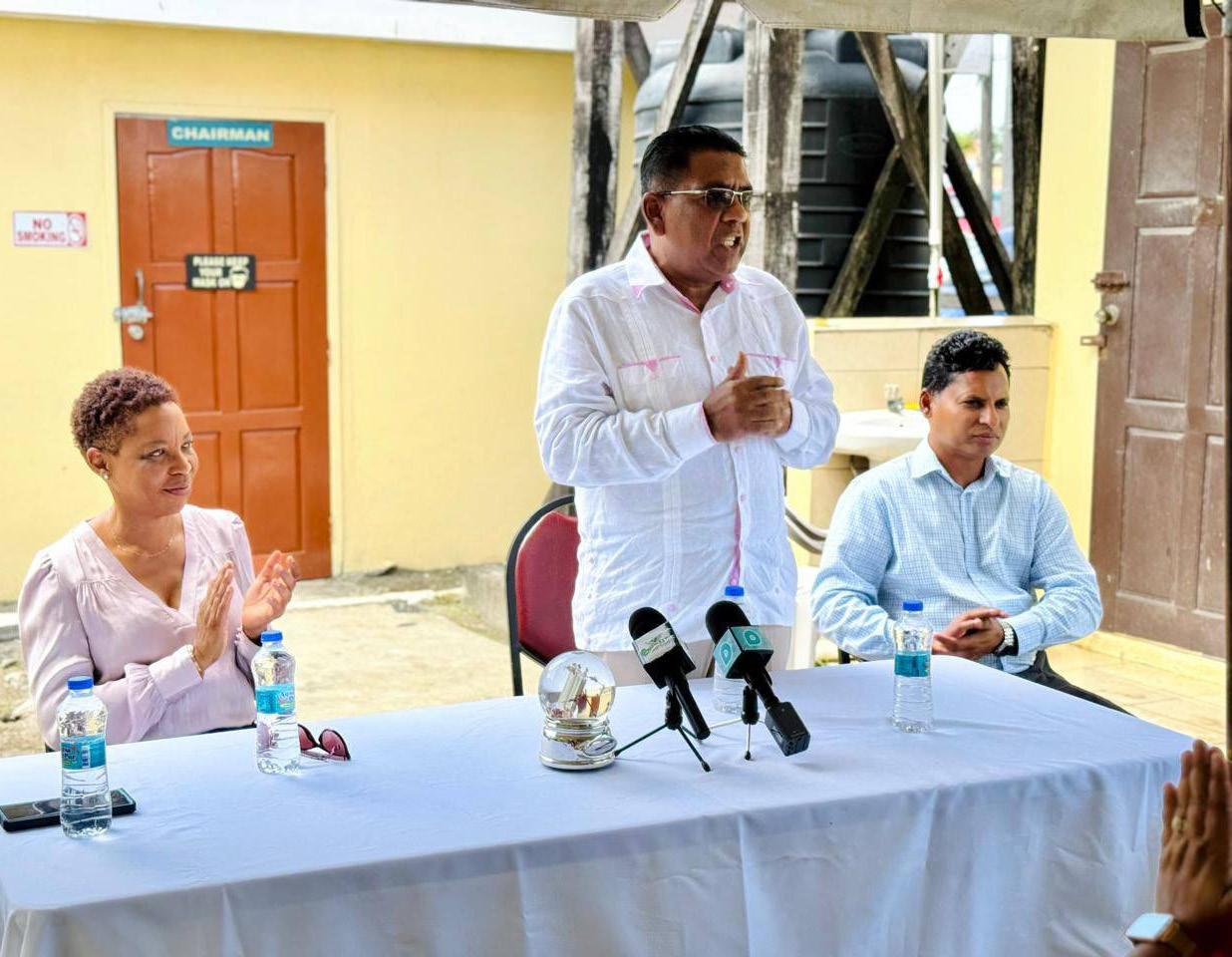

to enhance drainage capacity, we are also doing work to enhance drainage and irrigation in the communities. So, while we have NDIA doing work to clear and maintain the primary channels, we want to get the NDCs involved, but they may not have the equipment
to execute these works.
Over the years, we’ve been collaborating with various NDCs and municipalities,” Minister Mustapha said, adding:
“So far, we’ve handed over approximately 35 mini excavators to various bodies to carry out community enhancements. In the coming weeks, we’ll be handing over additional machines to NDCs on the East Coast and East Bank of Demerara, Region Five and Six.
We’ve already given machines to a number of NDCs in regions three and two.”
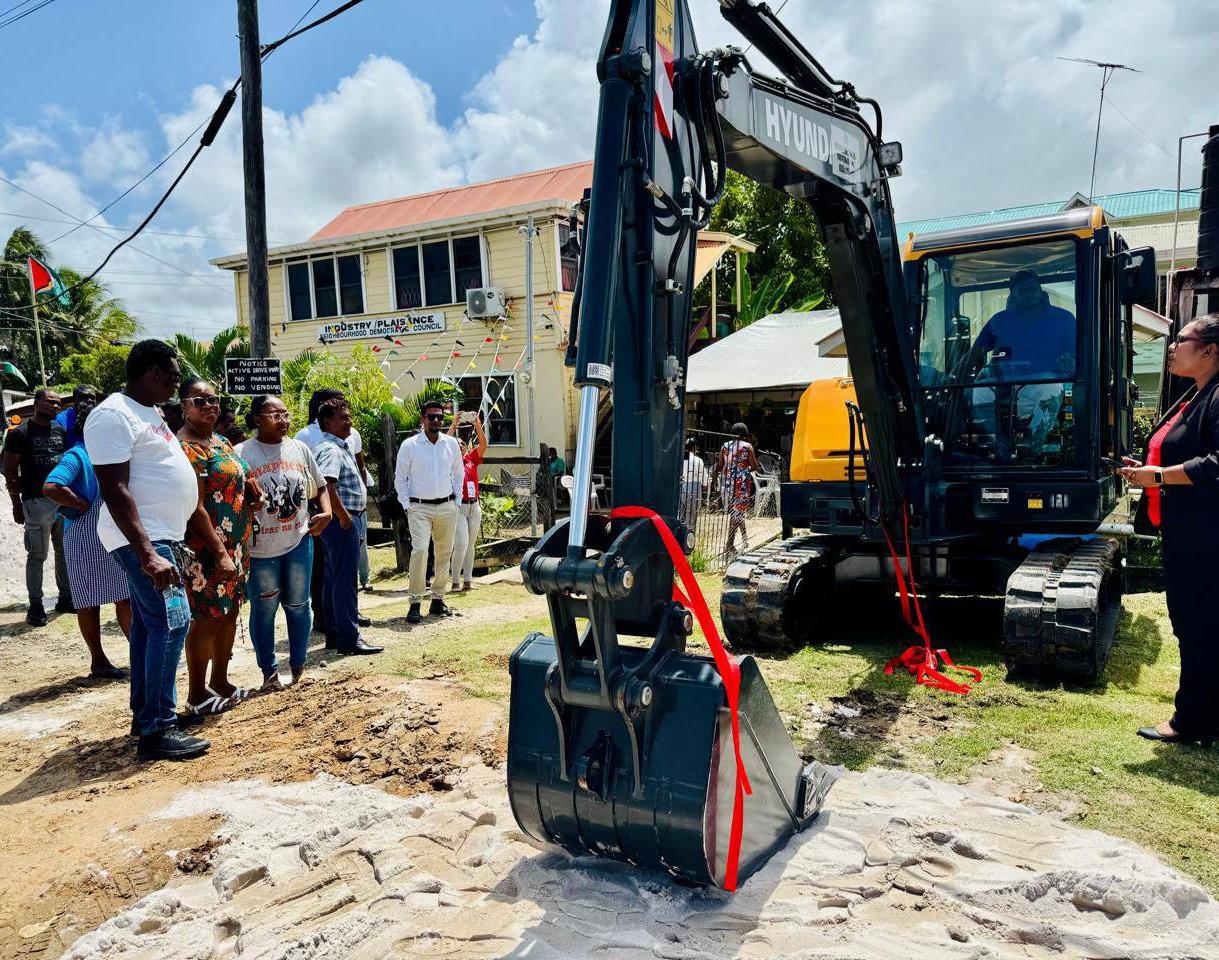

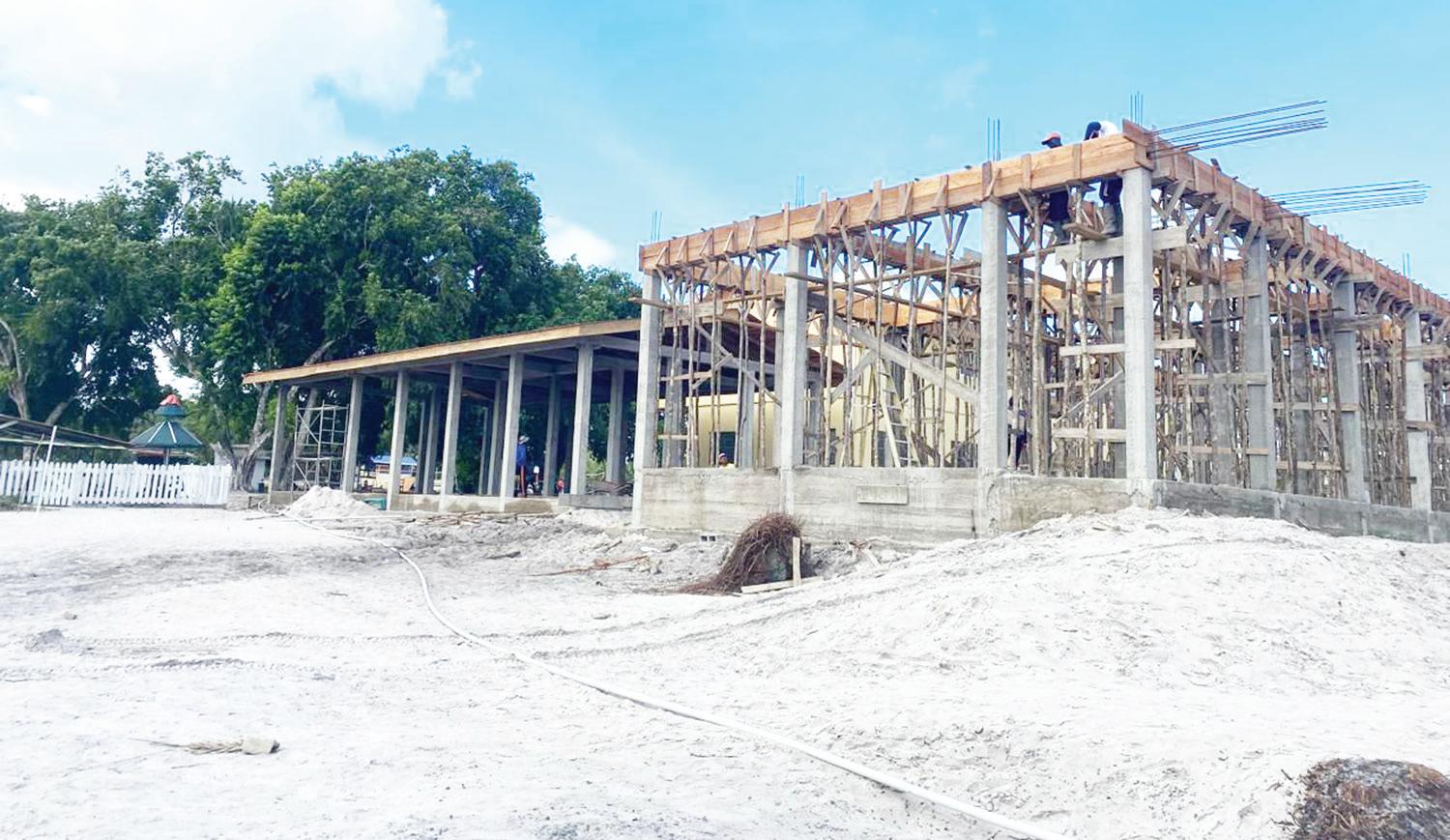
THE government is making significant strides in its commitment to universal secondary education with the ongoing construction of the Waramuri Secondary School.
This ambitious project, according to the Education Ministry, currently at 35 per cent completion, is set to open its doors in April,
marking a crucial step in expanding educational access for the nation's youth.
The new educational facility, being built at a cost of $326 million, is under the expert hands of Trevon David Construction Services. This substantial investment underscores the government's dedication to improving educational infra-
structure across the country.
The project's foundation was officially laid last year, when Minister of Education Priya Manickchand performed the sod-turning ceremony.
As the construction progresses, anticipation grows for the positive impact this school will have on local students.
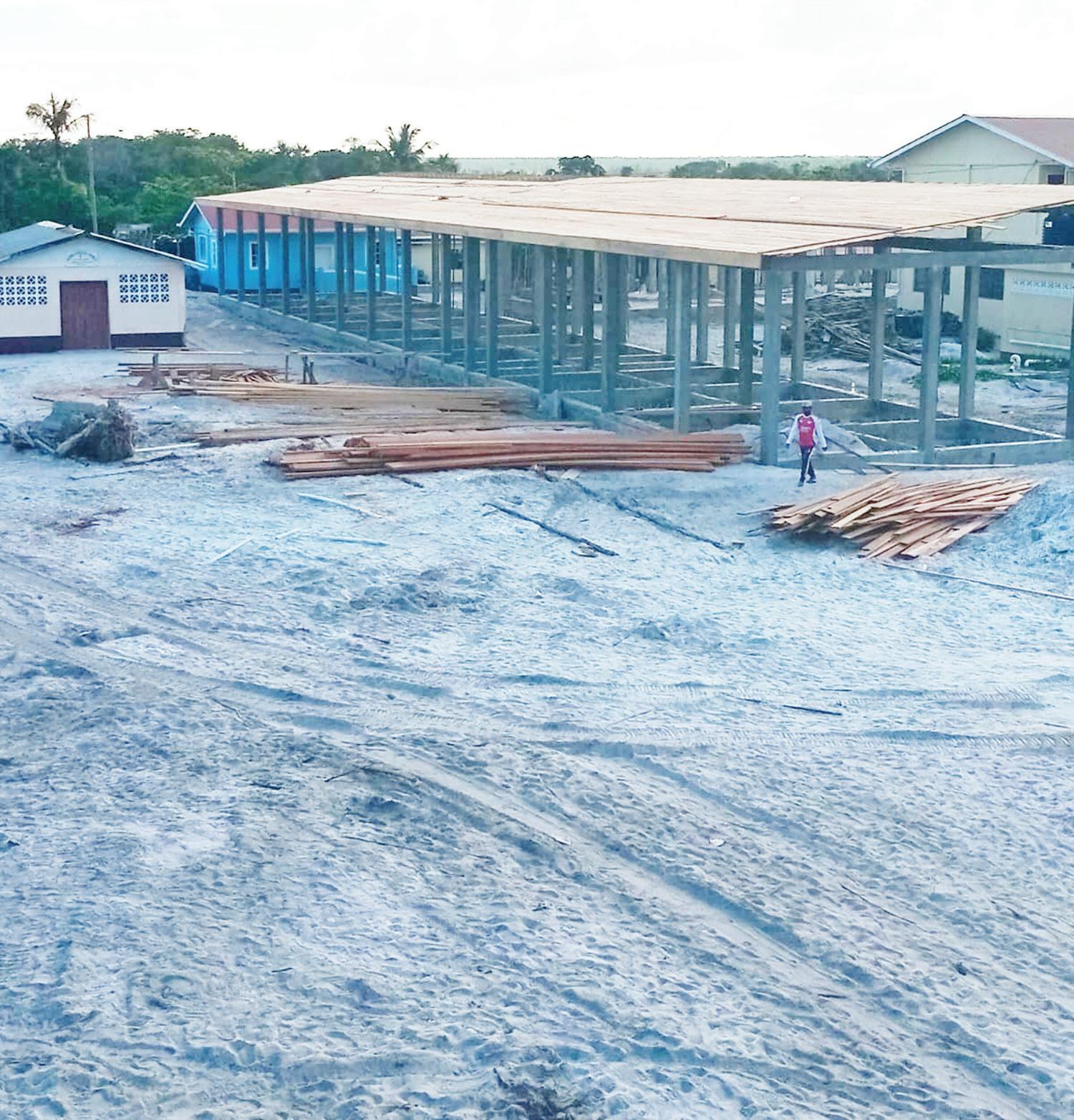
The government is making significant strides in its commitment to universal secondary education with the ongoing construction of the
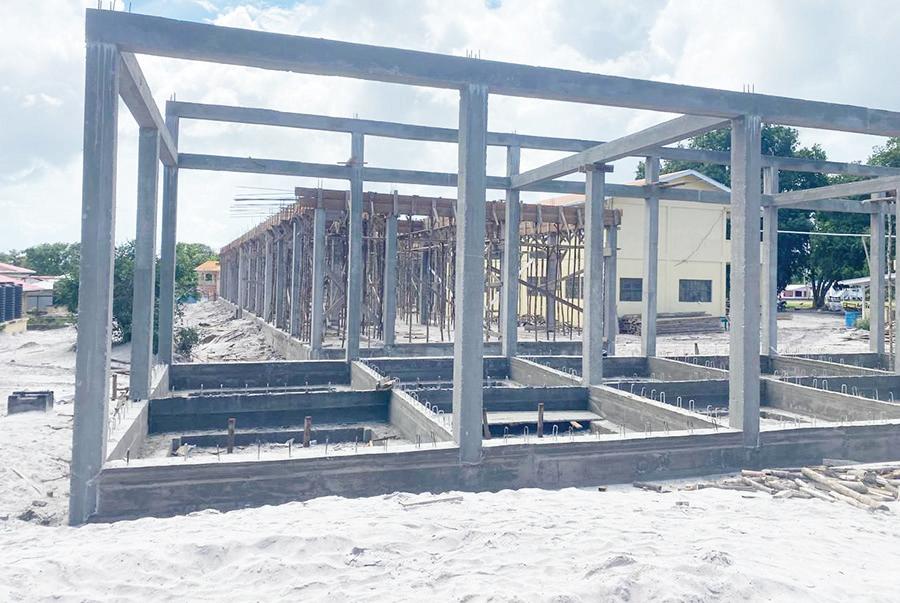
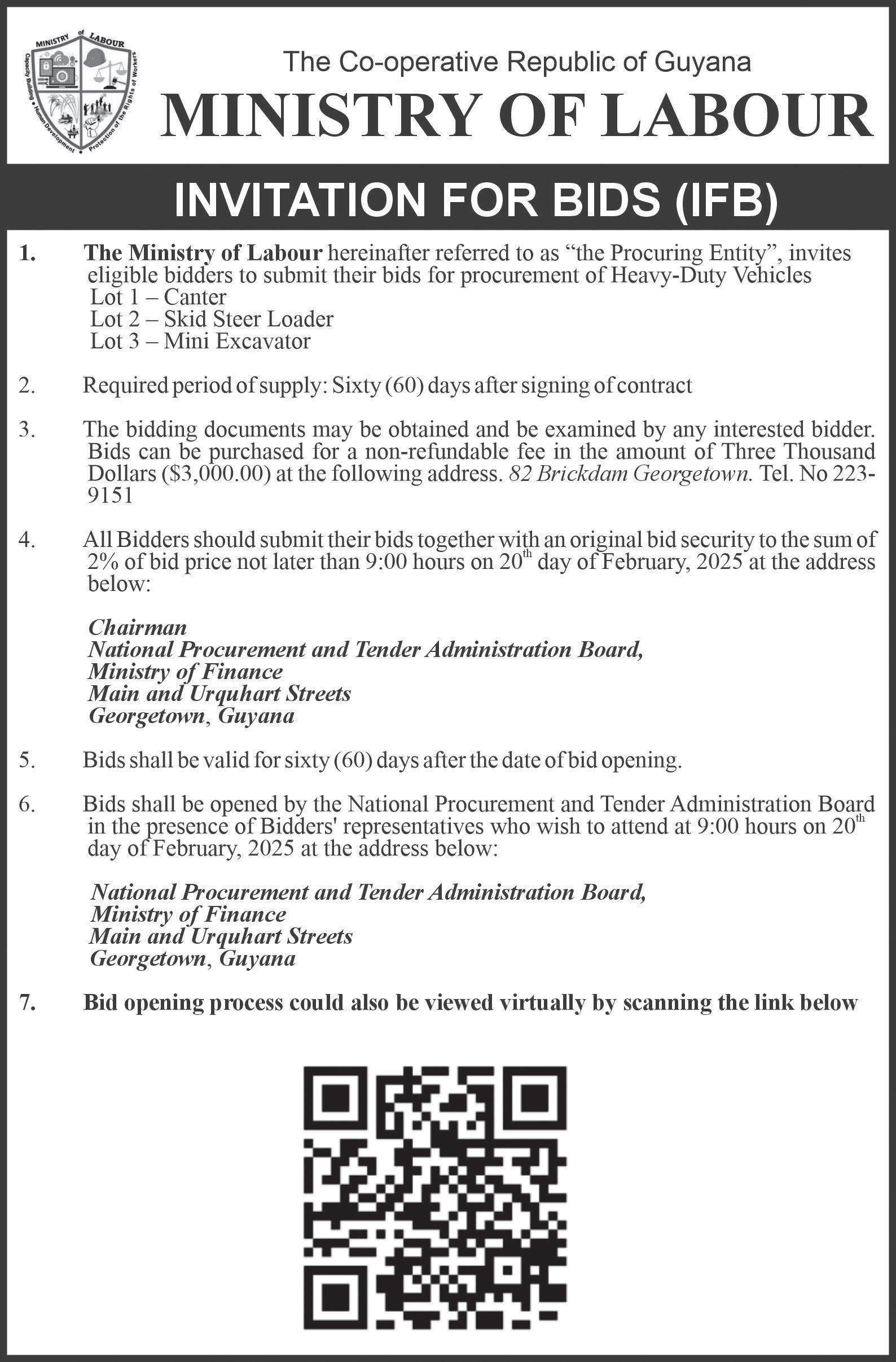
THE much-anticipated East Coast Demerara-East Bank Demerara road linkage, which is aimed at bolstering connectivity and easing traffic woes, is 94 per cent complete, Public Works Minister, Juan Edghill has said.
The minister said that it is slated to be completed before the end of this month, during day one of the consideration of estimates and expenditures of Budget 2025.
He said: “This project even though criticised during the general debate that it is behind time, is 94 per cent completed,” adding: “We have also ensured that the connector from Haags Bosch road move from two lanes to four lanes, and all of that is being completed before February end, of this year.”
Initially, there were squatters in the path of the road linkage’s development, however, the minister said
that the residents agreed to be relocated.
However, this is a vast contrast to what occurred in Peter’s Hall when the government sought to acquire property for the construction of the new Demerara River Bridge.
These Peter’s Hall residents, the minister pointed out, were motivated by political opponents, who attempted to obstruct development.
In this regard, Edghill said: “It shows you the difference when human beings act as patriots and citizens as against when they’re politically inspired.”
Opposition Parliamentarian, David Patterson, who quizzed the minister on the project, sought to imply that the residents of Peter’s Hall were unfairly compensated, noting that this was not the same for Ogle residents.
In response, Edghill boldly stated that those Ogle squatters received no more than $2 million in compensation.
While there was heckling from the Opposition bench when Patterson made that spurious claim, there was resounding silence when the minister responded.
The residents that were in the way and refused to move to enable the construction of the Demerara River Bridge, stalled its development even though the government made generous offers.
After the matter reached the courts, the ruling handed down ordered that the Peter’s Hall residents get less compensation than what the government initially offered.
A US$106.4 million contract was signed in June 2022 for the construction of the first phase of the ECD to EBD road linkage project.
At the signing ceremony, which was held at the intersection of the Rupert Craig Highway and Ogle Road on the East Coast of Demerara, it was announced that an India-based construction company, Ashoka Buildcon Limited, will take on the project which is expected to be carried out over 24
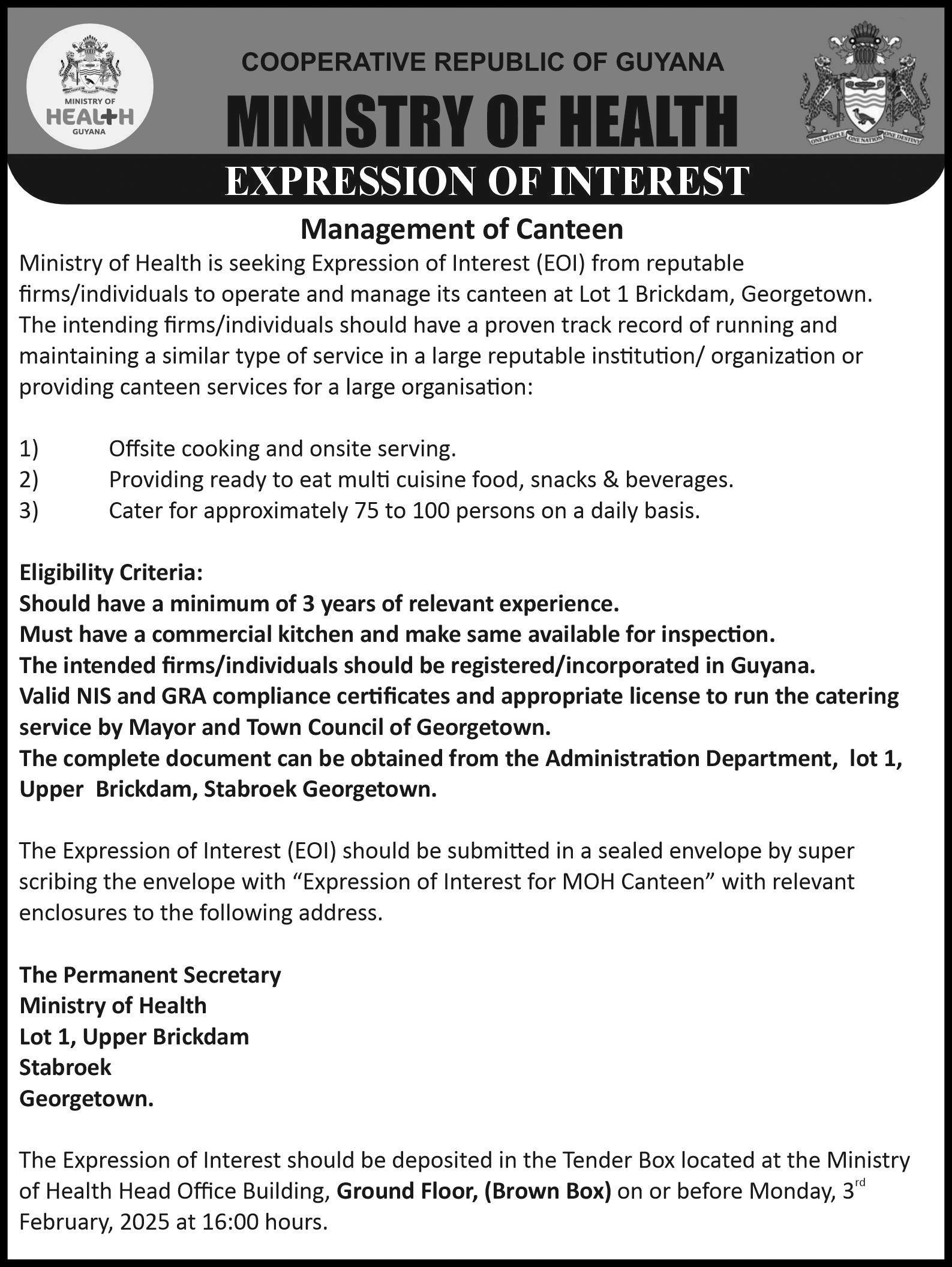
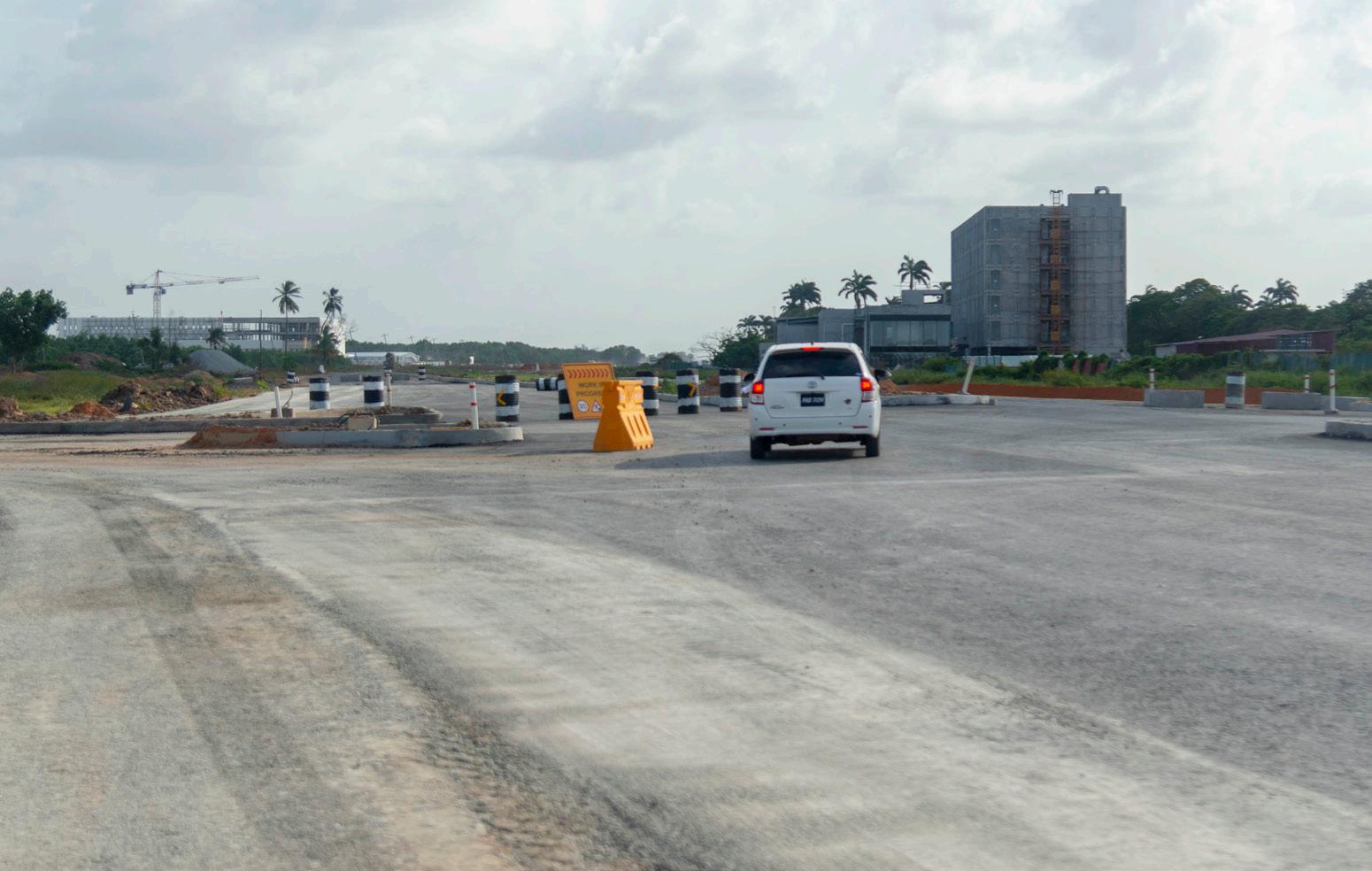
months.
The first phase of the road was expected to be a four-lane highway that stretches some 7.8 kilometres, with each lane being 3.6 metres wide. The road will also feature a median, sidewalks, and several structures along the way.
Road on the ECD in the direction of
The four-lane roadway is being constructed from the junction of the Rupert Craig roadway and Ogle Airstrip
in Eccles on the EBD. It will have a roundabout that will link the roadway with the expanding Railway Embankment.
SOME $80 million has been allocated this year to address the review and revision of the Amerindian Act of 2006, Minister of Amerindian Affairs Pauline Sukhai has said.
This forms part of the $7.2 billion that was allocated to the ministry in Budget 2025. This allocation was scrutinised during a sitting of the Parliamentary Committee of Supply on Monday.
Several Opposition Members of Parliament (MPs) questioned the minister about the Act. One of those MPs asked her about the estimated date of completion.
In response, she said: “It’s a work in progress; we are still addressing the education and awareness component of the activity.”
Notably, for decades before the restoration of democracy in 1992, Guyana’s indigenous communities faced systematic neglect, entrenched poverty, and deliberate marginalisation under the People’s National Congress (PNC) government’s policies, which left them isolated, forgotten, and disrespected, President Dr. Irfaan Ali had highlighted last year during his address at the opening ceremony of the National Toshaos Council (NTC) Conference.
Further, the President had condemned the period of
regression and neglect during 2015-2020, under the A Partnership for National Unity + the Alliance for Change (APNU+AFC) administration.
President Ali said that the tide turned with the People’s Progressive Party/Civic (PPP/C) government, which embarked on a mission to not only uplift these communities but to also correct the historical injustices that had long plagued them.
President Ali first said that before 1992, indigenous communities in Guyana were systematically side-lined, and their needs were often dismissed as inconsequential by the ruling PNC government.
However, the narrative of neglect began to change dramatically after 1992, when the PPP/C government took office.
President Ali said that despite inheriting a broken economy with enormous debts and “no oil revenues”, the PPP/C government prioritised the upliftment of indigenous communities, determined to rectify the historical wrongs.
With capital expenditure for Amerindian communities increased 25-fold under the PPP/C government, President Ali highlighted that this investment translated into significant improvements in health, education, infrastructure, and overall quality of
life for indigenous people.
One of the first major steps was the creation of the Ministry of Amerindian Affairs, which replaced the ineffective department that had previously handled issues related to Indigenous Peoples.
This ministry, which, he said, is the “most dynamic ministry” in Guyana became an active force in advocating for and addressing the needs of Amerindian communities.
The passage of the Amerindian Act of 2006 was a landmark achievement during this period. This legislation provided legal recognition of Amerindian land ownership and outlined the processes for demarcation and titling.
According to President Ali, this was not just a legal formality; it was a profound affirmation of the rights and autonomy of the Indigenous Peoples of Guyana. This act alone empowered indigenous communities, giving them the legal tools to protect and manage their ancestral lands.
Despite the progress made, President Ali said that the 2015-2020 period under the APNU+AFC government saw many of these gains eroded.
The President did not mince words in describing this period as one of “destruction, stagnation, and disrespect” for indigenous communities.
THE Guyana Police Force (GPF) Credit Union Department has officially opened its brand-new canteen, ‘Uni Coop Cafeteria,’ at its Credit Union Office on Camp Street, Eve Leary.
The unveiling, which took place on Friday, January 31, 2025, marks a significant milestone in enhancing the welfare and convenience of staff, officers, and visitors.
The event was chaired by Woman Assistant Superintendent Jillian Moore-Bowen, who led the proceedings, beginning with an opening prayer and the recitation of the National Pledge.
Following the formalities, Woman Superintendent Leslyn Smith provided an overview of the vision behind the initiative, emphasising its importance in fostering a supportive and efficient work environment. She then introduced Commissioner of Police, Mr. Clifton Hicken, who delivered the keynote address, commending the team for its efforts in making the cafeteria a reality. He expressed his gratitude to the staff and reaffirmed his commitment to supporting similar welfare initiatives.
Amid a warm ambience and a musical interlude by Corporal Daly, the highlight
of the ceremony was the unveiling of the ‘Uni Coop Cafeteria’ plaque, featuring the Commissioner of Police, Board of Directors, and staff members, officially marking the canteen’s opening.
GPF Credit Union Manager, Ms. Donna Todd, concluded the event with a heartfelt ‘Vote of Thanks’, expressing appreciation to everyone who contributed to the project’s success.
The ceremony was attended by several distinguished guests, including Head of the Guyana Prison Service, Mr. Nicklon Elliot, and Secretary of the Guyana Police Force Credit
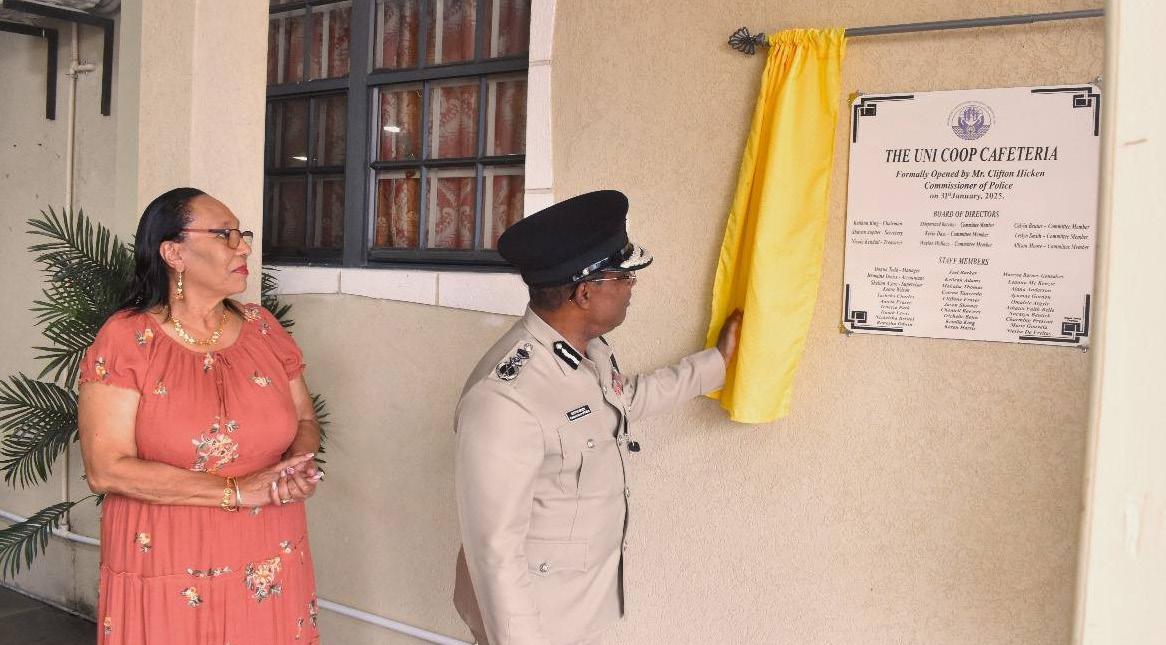
Union, Woman Superintendent Shavon Jupiter, along with other officers, ranks, and special invitees.
The ‘Uni Coop Cafeteria’ is expected to provide quality meals and refreshments for staff and visi -
tors, reinforcing the Credit Union’s ongoing commitment to the well-being of its members.
AS part of the Guyana Police Force’s ongoing commitment to engaging with communities and fostering partnerships with residents, the business community, and the general public, a police-led outreach was
conducted to address concerns and develop collaborative solutions for maintaining peace and security.
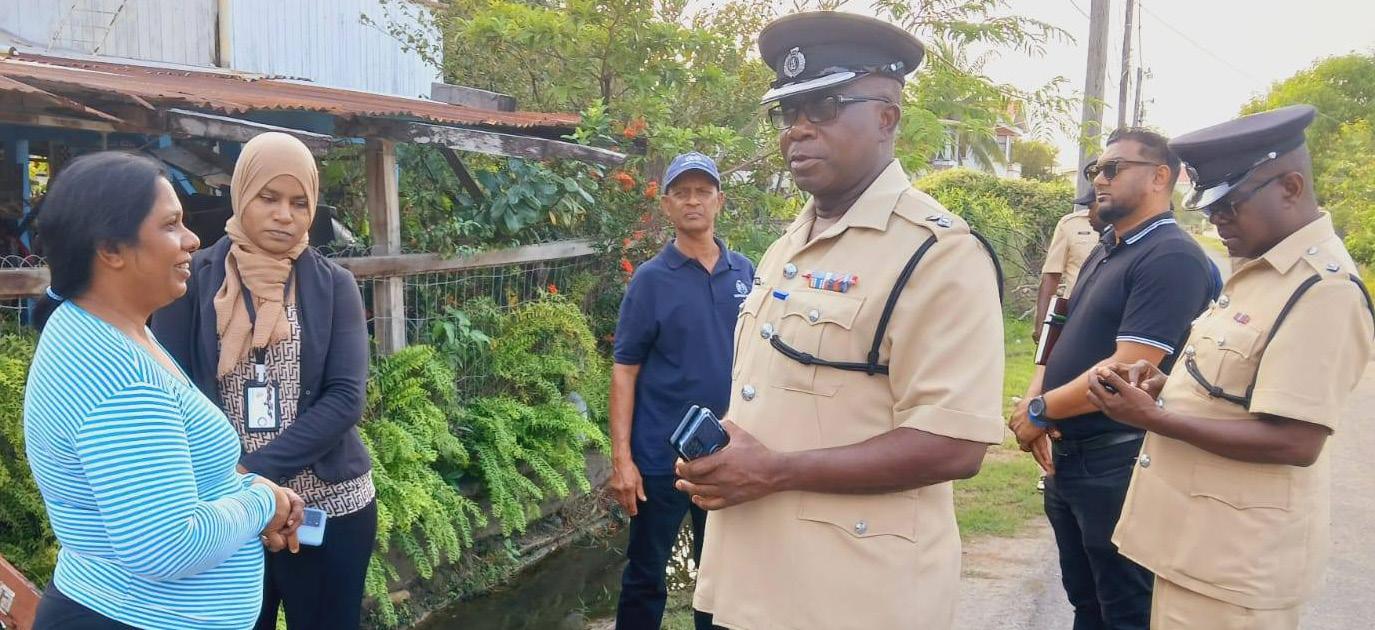
Divisional Commander, Senior Superintendent Ewart Wray, flanked by police ranks, speaks with one of the many Enterprise residents during the outreach
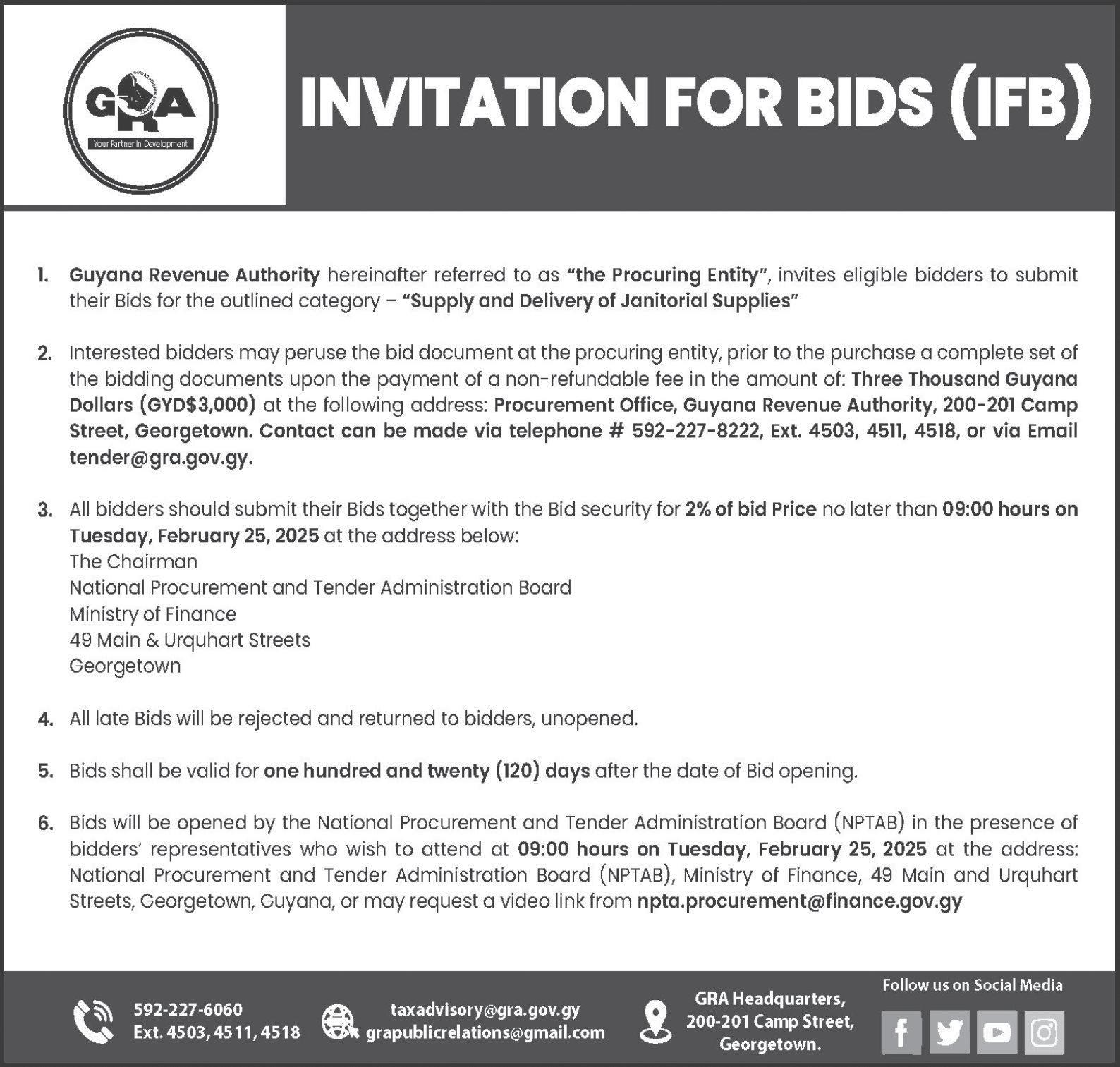
On Friday, January 31, 2025, between 15:30 hrs and 17:00 hrs, Senior Superintendent Ewart Wray led a police team into the community of Enterprise, located on the East Coast of Demerara. The visit aimed to engage with residents, listen to their concerns, and collaborate on finding amicable and workable solutions to community issues.
Commander Wray was accompanied by Traffic Officer, ASP Harry; Divisional Detective, Inspector Komal
Pitama; Inspector Payne, D/ Sergeant Richards, Lance Corporal Murray, and other ranks from the Vigilance Police Station. Also present were members of the Enterprise Community Policing Group.
The outreach was part of the Police Force’s ongoing efforts to strengthen community engagement, build trust, and ensure public safety.
During the visit, residents actively interacted with the police team, raising various concerns and issues. The
team addressed these matters on the spot, providing solutions and assuring residents that their needs were being taken seriously.
Residents expressed their appreciation to Commander Wray and his team for their timely visit and commitment to maintaining safety and security in the community.
The outreach was widely seen as a positive step toward strengthening the relationship between the police and the residents of Enterprise Village.

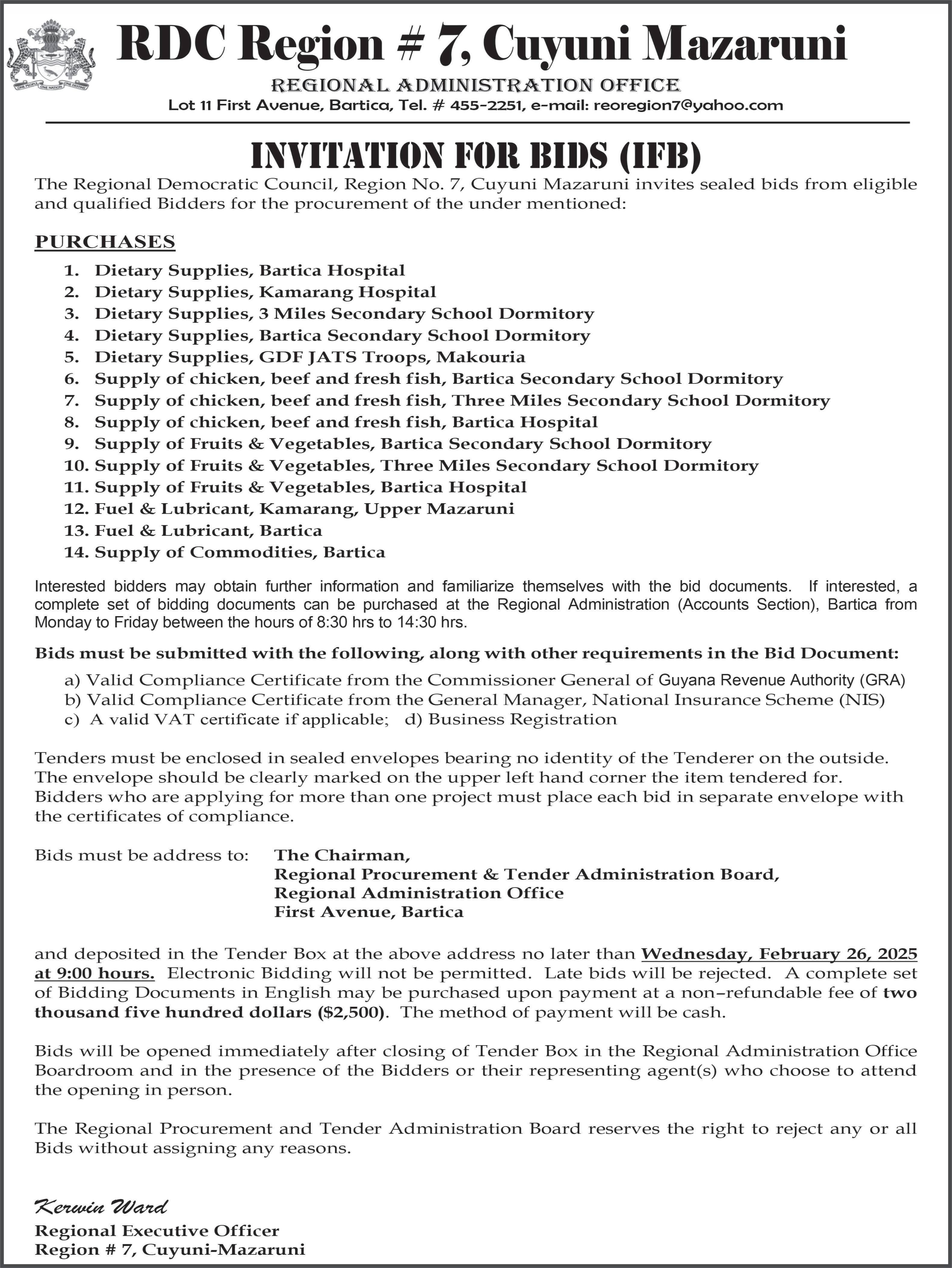
By Cindy Parkinson-Chowbay
RAISED by a single mother who worked tirelessly as a housekeeper to provide for her children, Minister within the Ministry of Public Works, Deodat Indar, has strongly condemned opposition member Juretha Fernandes for her disrespectful and demeaning remarks about Guyanese workers and their occupations.
During the 2025 budget presentation, Minister Indar expressed his deep disappointment over Fernandes’ comments, which he noted resonated with him on a personal level.
Fernandes had re -
ferred to certain occupations, including cleaners in the hotel industry, as “small jobs,” a characterisation that Indar and his colleagues found dismissive and offensive.
The minister emphasised that there is no shame in honest work, particularly among the youths who take on these roles. He noted that Minister of Tourism, Industry, and Commerce, Oneidge Walrond, had already addressed the issue, highlighting that such statements reflect a fundamental misunderstanding of the tourism sector and a disregard for hardworking Guyanese citizens.
Minister Indar shared his personal background
to underscore the value of honest labour. “I came from Vreed-en-Hoop. I was born and raised there, but my mother was a single parent. My father left when I was two years old, but my mother, who was a Tactical Services Unit (TSU) rank, also did cleaning work. She was a housekeeper. She had to press clothes, clean places, and cook, but she did it with dignity to take care of me and my siblings,” he stated.
He added, “Today, I stand in this honourable house as a member of the President’s Cabinet and the PPP/C government to defend those who work hard for an honest living.”
Minister Indar called on opposition members to
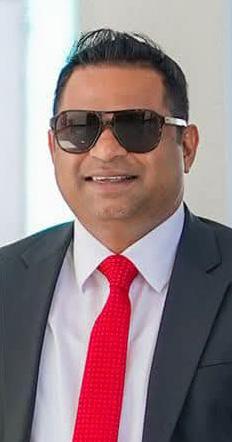
show respect for their fellow Guyanese, particularly the working class, who make significant contri-
butions to the nation’s development. He stressed that true service to the people requires genuine respect and appreciation for their efforts.
Additionally, Minister Indar addressed opposition member Sherod Duncan’s claims regarding job losses under the People’s Progressive Party Civic (PPP/C) administration. Refuting Duncan’s assertions, Indar argued that job creation stems from economic growth and expansion—something that did not occur under the previous APNU+AFC government.
“When you are speaking about jobs in Guyana, the generation of jobs comes from economic growth and expansion.
This did not happen under the APNU+AFC; the party was marred by people being fired day in and day out. They were the ones who put people out of work; their administration is marred by bullyism, repressiveness, stagnation, and the stifling of growth. Under their management, incompetence reached its peak. It’s not how much money you have; it’s how you use the little that you have,” he asserted.
Minister Indar’s remarks reinforced the government’s commitment to job creation, economic growth, and respect for all hardworking Guyanese citizens, regardless of their profession.

The following is the full text of a statement from the Chairman of the Presidential Commission for Non- Communicable Disease, Dr. Leslie Ramsammy:
“… FEBRUARY 4, marks twenty-five years of signing the Charter of Paris Against Cancer at the World Summit Against Cancer for the
New Millennium. The 2025 theme for World Cancer Day is ‘United by Unique’. Guyana’s Presidential Commission on the Prevention and Control of NCDs acknowledges the unique experiences of each and every single person living with cancer and that of their families.
We support and urge a comprehensive people-centred cancer care delivered
jointly by healthcare providers, families, friends and community.
Guyana has made notable progress in the fight against cancer. The Presidential Commission for the Prevention and Control of NCDs commend the Government of Guyana and the Ministry of Health for measurable progress in the prevention, diagnosis, treatment and care for cancer.
The significant increase in services for cancer at the GPHC is testimony to the dramatic increase in cancer care in Guyana. The GPHC now records an average of more than 50 new patients each month. At the end of 2024, the GPHC had 500 patients on active chemotherapy. In addition to medicines, treatment and care include psycho-social support. The number of

cancer medicines in use at GPHC has increased.
The recent expansion of chemotherapy through the GPHC to the New Amsterdam Hospital is a welcome development. The Commission is aware that approximately 100 patients are receiving chemotherapy through the New Amsterdam Hospital clinic, after initiation at the GPHC. This provides relief for patients and their families.
The Commission urges GPHC and the MOH to ensure that a similar extension occurs in 2025 to Linden Hospital (Region 10) and Suddie Hospital (Region 2).
In collaboration with the IAEA, four new mammography equipment have been added to the public sector. This is a significant improvement and provide an opportunity for more women to be screened for breast cancer.
The increase in capacity and capability of the new pathology lab at the GPHC adds to the early diagnostic and wider screening capability for cancer in the public sector.
The NCD Commission urges the Ministry to establish target populations for gastric, cervical, breast, lung and prostate cancers and to ensure that Guyana is achieving a target of 90% screening of the target population by World Cancer Day 2026. This is an ambitious goal, but we must make every effort to achieve it.
Guyana has been adjusting its health care model to fully implement Universal Health Care (UHC), one of the goals of the SDGs (SDG 3). As part of UHC, we must ensure cancer prevention and diagnosis are included in the package of services at all levels of care.
In this regard, we commend the GoG and the MOH for its continued consolidation of the nationwide Human Papillomavirus vaccination programme and its cervical cancer screening programme.
The Commission would like a similar approach of integrating within the UHC, prevention and screening programmes for breast cancer, prostate cancer, gastric cancer and lung cancer.
The Commission urges the MOH to urgently formalise a childhood cancer programme. With the strong evolution of an Oncology
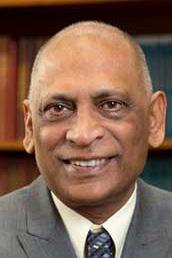
Programme at GPHC, the impending opening of the Paediatric Women Hospital at Ogle in early 2026 and the establishment of a Cancer Treatment Centre by 2028, as announced by President Irfaan Ali, the MOH must move rapidly to formalise a childhood cancer programme.
The Commission is pleased to note the improvement of the National Cancer Registry and look forward for a world-class Cancer Registry.
While acknowledging the notable improvement in cancer prevention, diagnosis, treatment and care in the public sector, we cannot ignore persistent challenges. Existing cancer prevention policies and programmes are not fully implemented.
We urge the MOH to publish the package of services for cancer available in Guyana today and those planned for introduction in 2025. Screening for specific cancers is low, even for cervical cancer where testing capacity has been established. For example, cervical cancer screening is less than 50% the target population.
Late diagnosis, when treatment is generally less effective and costlier, is common.
“While rapid improvement is occurring, like in all developing counties, national capacity remain inadequate to manage the increasing cancer burden. Urgent steps must be taken to align capacity with the growing cancer burden in Guyana.
The Commission urges the MOH to prioritise in 2025 its cancer medicine list and its procurement.”

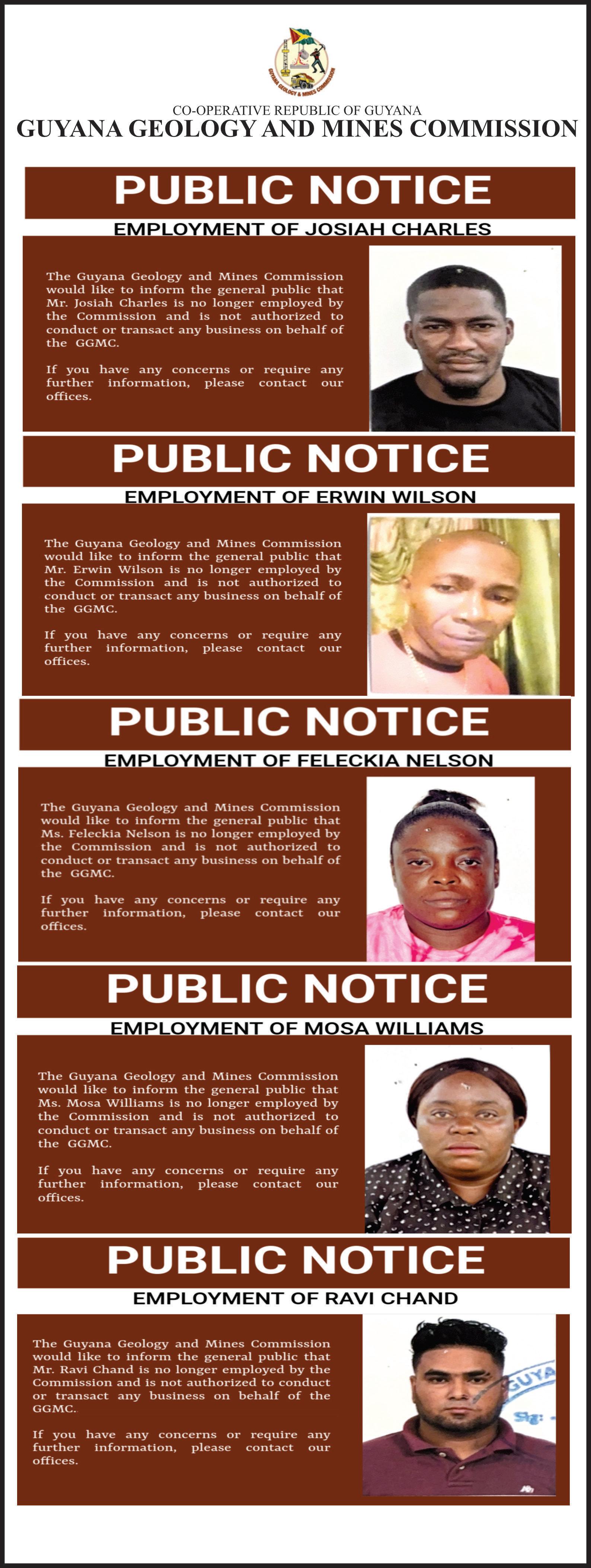
–– industry leaders push for 5G, Fiber, and a Unified ICT Framework
SPEAKING at the CANTO gathering in Curaçao, Damian Blackburn, President of International Operations at One Communications, underscored the urgent need for regional collaboration to achieve the vision of a “Caribbean Gigabit Society” by 2030.
In his keynote address, Blackburn emphasised that unity among industry stakeholders is the key to success, invoking the African proverb: “If you want to go fast, go alone.
If you want to go far, go together.”
Acknowledging CANTO’s decades-long commitment to advocacy, capacity building, and digital transformation across the region, Blackburn noted that One Communications and its parent company, ATN International, have maintained deep ties with the organisation for over 20 years. He credited CANTO with providing a vital platform for fostering innovation, knowledge-sharing, and regulatory support to advance the Caribbean’s telecommunications landscape.
Blackburn highlighted the collaborative efforts behind the CARICOM Working Group’s 2024 report, Towards a Caribbean Gigabit Society 2030, which outlines a transformative roadmap to create a digitally integrated, globally competitive region. The plan aims to expand high-speed connectivity through 5G networks and Fiber-to-the-Home (FTTH), ensuring universal internet access with speeds starting at 100 Mbps, scalable to 1 Gbps.
The report identifies three key pillars essential for achieving this vision: 5G and FTTH Coverage Targets – Establishing clear, measurable infrastructure deployment goals; Addressing the Funding Gap – Advocating for financial contributions from major Big Tech OverThe-Top (OTT) providers to support broadband expansion; and Regulatory Harmonisation – Developing a unified framework for digital trade, AI integration, cybersecurity, and the creation of a Single ICT Space.
In a statement released
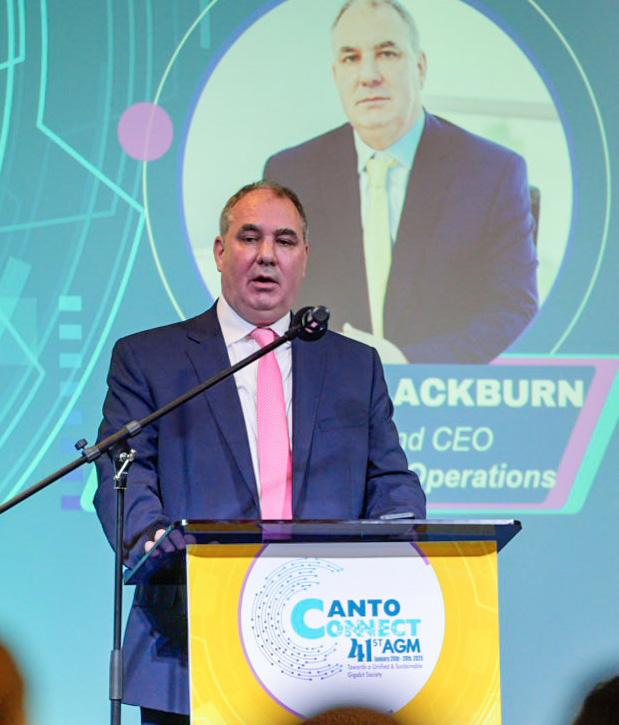
Damian
by CANTO, the organisation highlighted that over USD $9 billion is needed to support the Caribbean’s transition to a Gigabit Society. Lisa Agard, Chair of the CANTO C9 Steering Group, noted that 70% of network data usage in the region comes from OTT services provided by global tech giants—yet these companies do not contribute to infrastructure investment or maintenance.
“Operators are facing increasing demands for data capacity, but without contributions from Big Tech, the burden falls solely on network providers,” Agard emphasised.
Blackburn detailed One Communications’ proactive steps in advancing the Caribbean Gigabit Society. He highlighted the company’s recent rebranding, reflecting its strategic investments in fiber, 5G, and premium customer experiences. Additionally, he introduced Brava, One’s enterprise solutions brand offering cybersecurity, cloud-based services, and mission-critical business support.
“We know we cannot achieve this vision alone,” Blackburn stated. “Collaboration is essential, and we must innovate together to serve the people of the Caribbean in new and transformative ways.”
Blackburn pointed to
Guyana as a prime example of effective industry collaboration, showcasing initiatives such as: MMG Digital Payments – Enabling mobile top-up payments across all network operators; and Shared Network Infrastructure – Leveraging fiber assets to improve resilience and support independent wireless ISPs.
Reflecting on his 17year journey in the Caribbean telecommunications industry, Blackburn shared his inspiration from collaborative efforts across the region, including his work with President Jimmy Carter and Habitat for Humanity in Haiti.
He closed his address by invoking the words of John Lennon’s Imagine, reinforcing a shared vision for a connected and sustainable future:
“You may say I’m a dreamer, but I’m not the only ONE. I hope someday you’ll join us, and the world will live as ONE.”
With Dr. Delreo Newman stepping in as CANTO’s new chairman, Blackburn reaffirmed One Communications’ unwavering commitment to digital transformation in the Caribbean, ensuring that no one is left behind on the path to a fully connected future.
ON World Cancer Day 2025, the Georgetown Public Hospital Corporation (GPHC), on Tuesday, marked a significant milestone with the official certification of its Pathology Laboratory by the Guyana National Bureau of Standards (GNBS).
The certification, which recognises compliance with the GYS 170:2021 standards for laboratory operations, coincides with the first anniversary of the laboratory’s commissioning.
For years, high-quality pathology services in Guyana were largely confined to the private sector, often requiring specimens to be sent overseas for diagnosis or leading to prolonged wait times. This certification underscores the GPHC Pathology Laboratory’s commitment to improving local diagnostic services, ensuring timely and accurate results for patients across the country.
The GYS 170:2021 certification outlines essential requirements for laboratory operations, including quality management, administrative efficiency, and technical precision. With this achievement, GPHC’s Pathology Laboratory is setting a new benchmark for
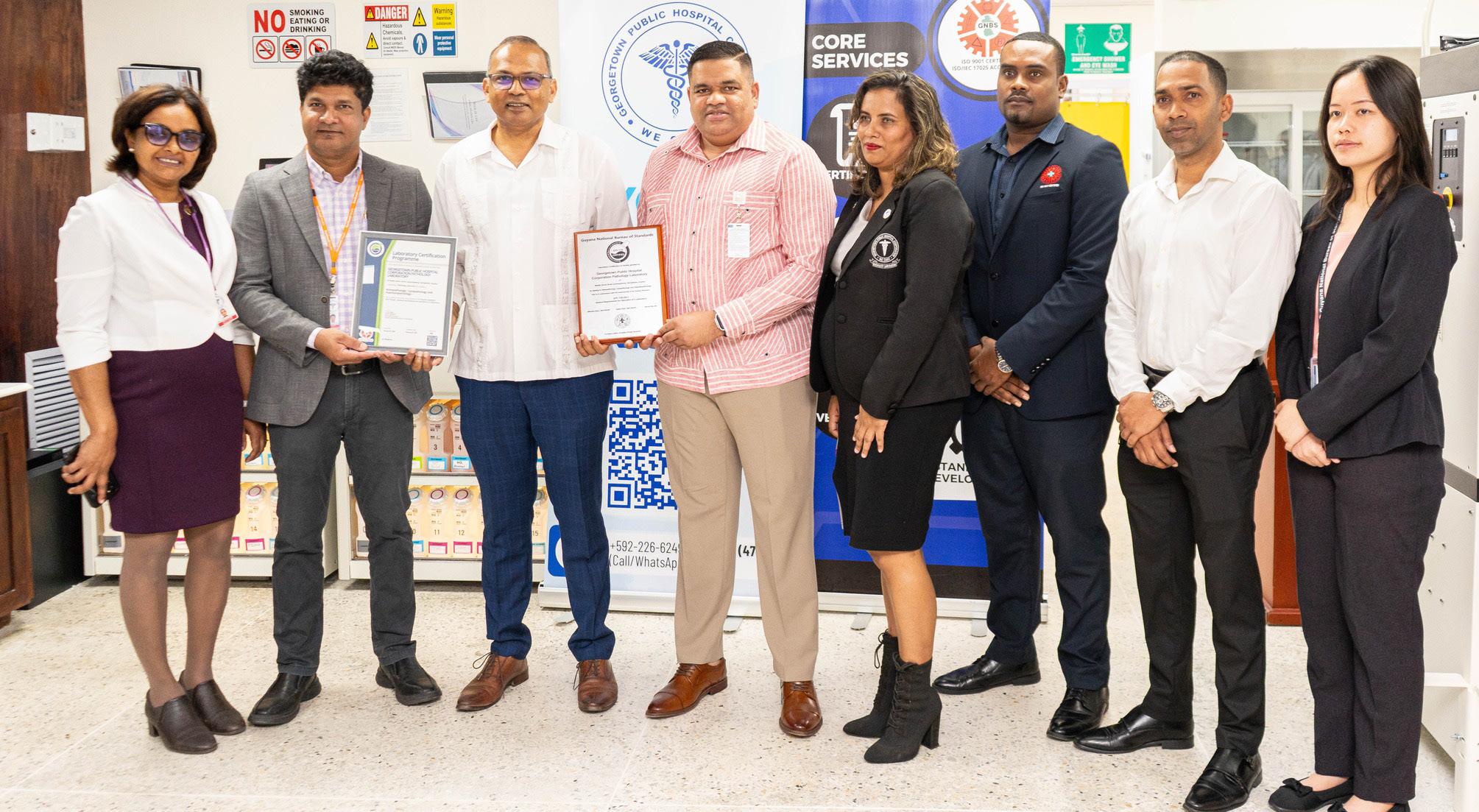
and other officials with the official certification of its Pathology Laboratory by the GNBS
public healthcare, enhancing service delivery across Guyana’s ten administrative regions.
GPHC CEO, Mr. Robbie Rambarran, expressed his pride in the laboratory’s advancement, stating, “Many people rely on accurate pathological diagnoses, and we will continue to strengthen this area to better serve our population.” The laboratory has experienced
significant improvements in specimen intake, processing, and communication, all of which contribute to more efficient patient care.
One of the lab’s most notable advancements has been the transition from a paper-based system to an electronic data management system, streamlining reporting and accessibility for physicians. Additionally, training initiatives have
expanded, with medical technologists developing expertise as histotechnologists, General Medical Officers (GMOs) being trained as grossing technicians, and a pathologist receiving advanced diagnostic training.
The certification ceremony featured remarks from key stakeholders, including Minister of Health, Dr. Frank Anthony, GNBS Executive Director Mr. Trevor Bassoo, and Chief
Transformation Officer at Mount Sinai Health Systems, Mr. Art Gianelli.
GPHC Pathology Laboratory Manager, Ms. Maricea Comacho, reflected on the achievement, stating, “In 2013, establishing standard operating procedures and achieving compliance was a challenge. Today, we not only meet these standards, but we also have the resources and commitment to sustain them.”
In recognition of their dedication, pathology laboratory staff members received certificates of appreciation for their role in achieving certification. This milestone, more than 60 years after the laboratory’s inception, demonstrates GPHC’s commitment to elevating healthcare standards in Guyana.
Moving forward, the GPHC Pathology Laboratory remains dedicated to maintaining and advancing these high standards, ensuring that all Guyanese have access to reliable, high-quality diagnostic services.
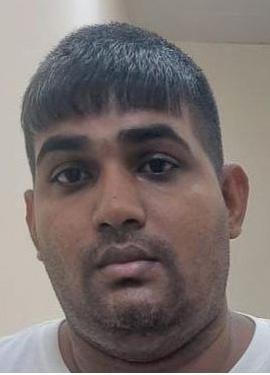
RONALD Balgobin, a 31-year-old taxi driver from Cinderella City and Amelia’s Ward, Linden, has been formally charged with abduction and breach of a protection order following an incident involving his former partner, Basmattie “Penny” Bassant, a 37-year-old housewife from Annandale, East Coast Demerara. Balgobin, who was previously wanted by law enforcement, was captured and brought before the Vigilance Magistrate’s Court on February 3, 2025. The charges stem from an alleged abduction that occurred on October 27, 2024, at around 10:00 hrs in Annandale, ECD. Before His Worship Sunil Scarce, Balgobin was remanded to prison on the abduction charge, and the case was adjourned to March 13, 2025, for
further reporting. Meanwhile, he pleaded guilty to breaching a protection order, an offence under the Family Violence Act of 2024 (#14), and was sentenced to eight months in prison.
Notably, the victim, Ms. Bassant, who had been advised to attend the hearing, was absent from court on the day of Balgobin’s appearance.
Authorities continue to emphasise the importance of enforcing protection orders to safeguard victims of domestic violence and are urging individuals facing similar threats to report incidents promptly.
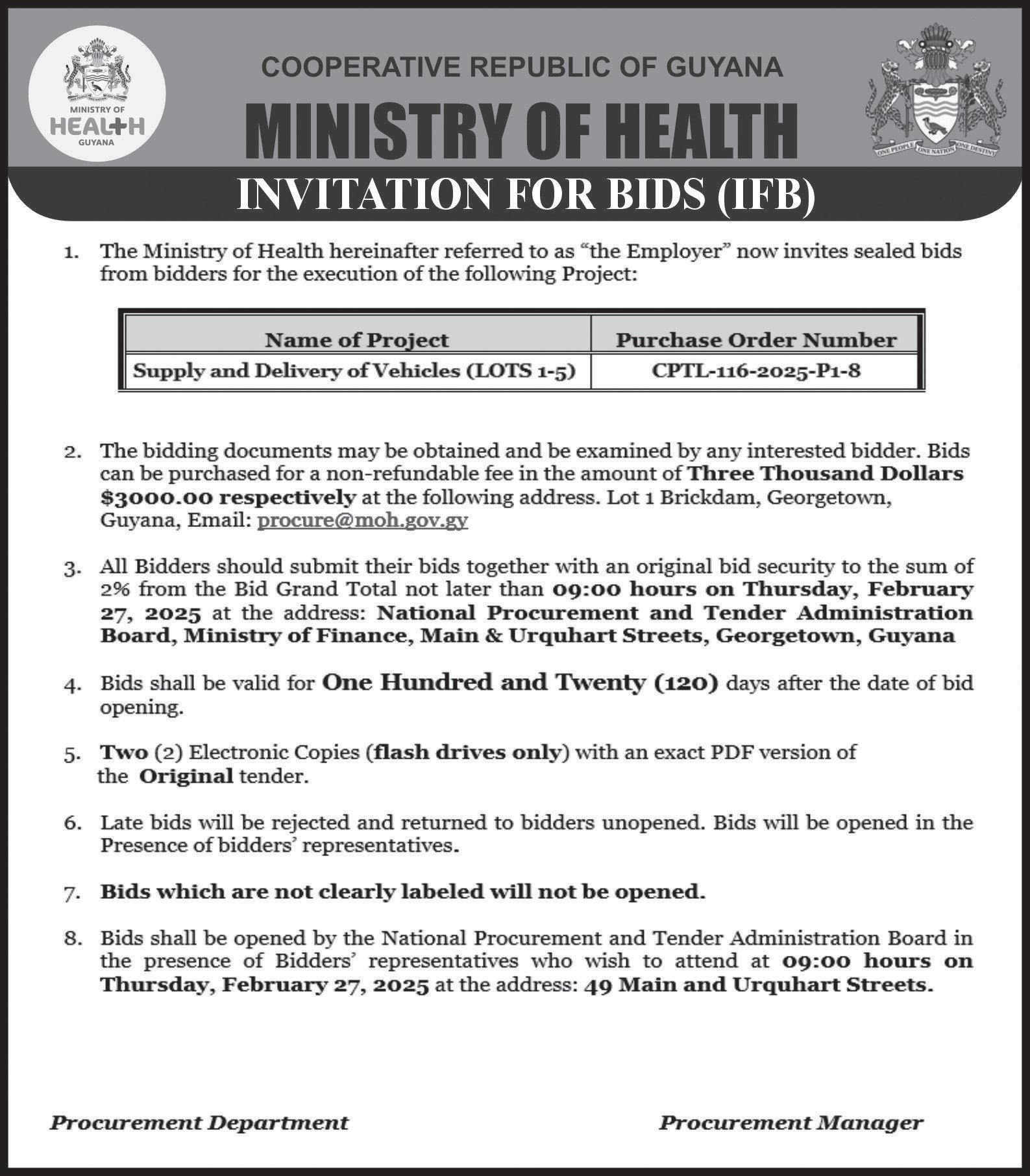
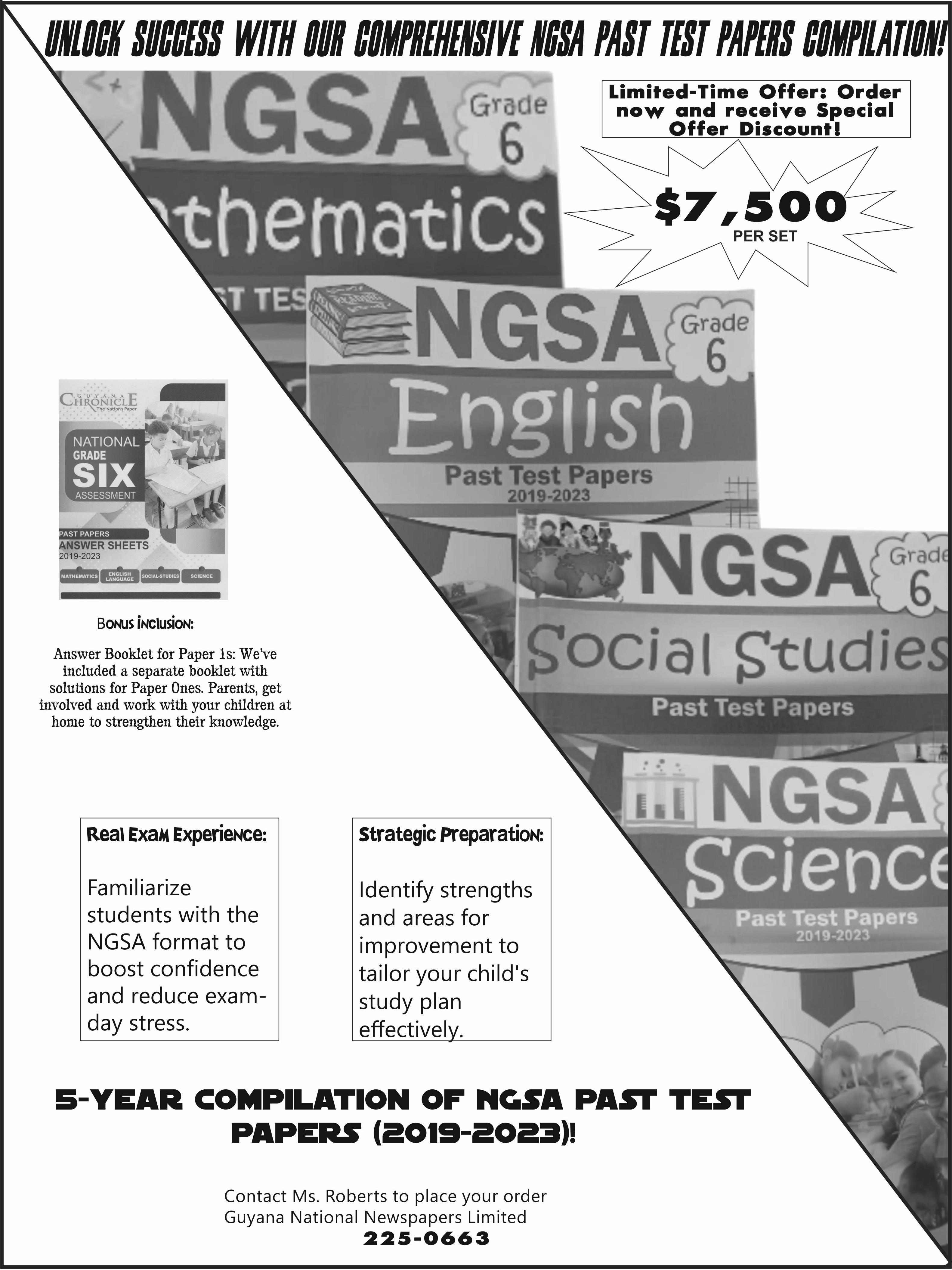
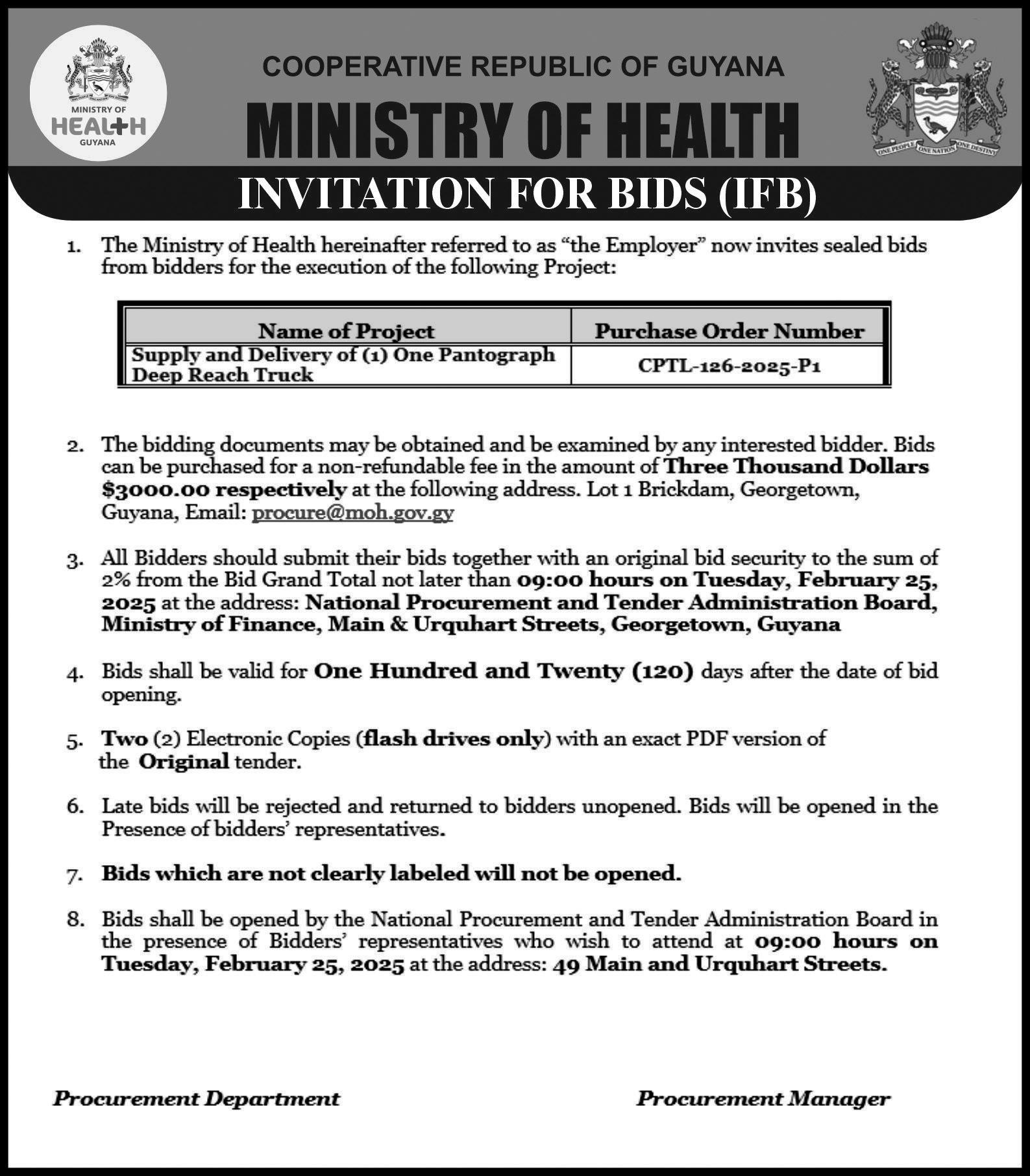
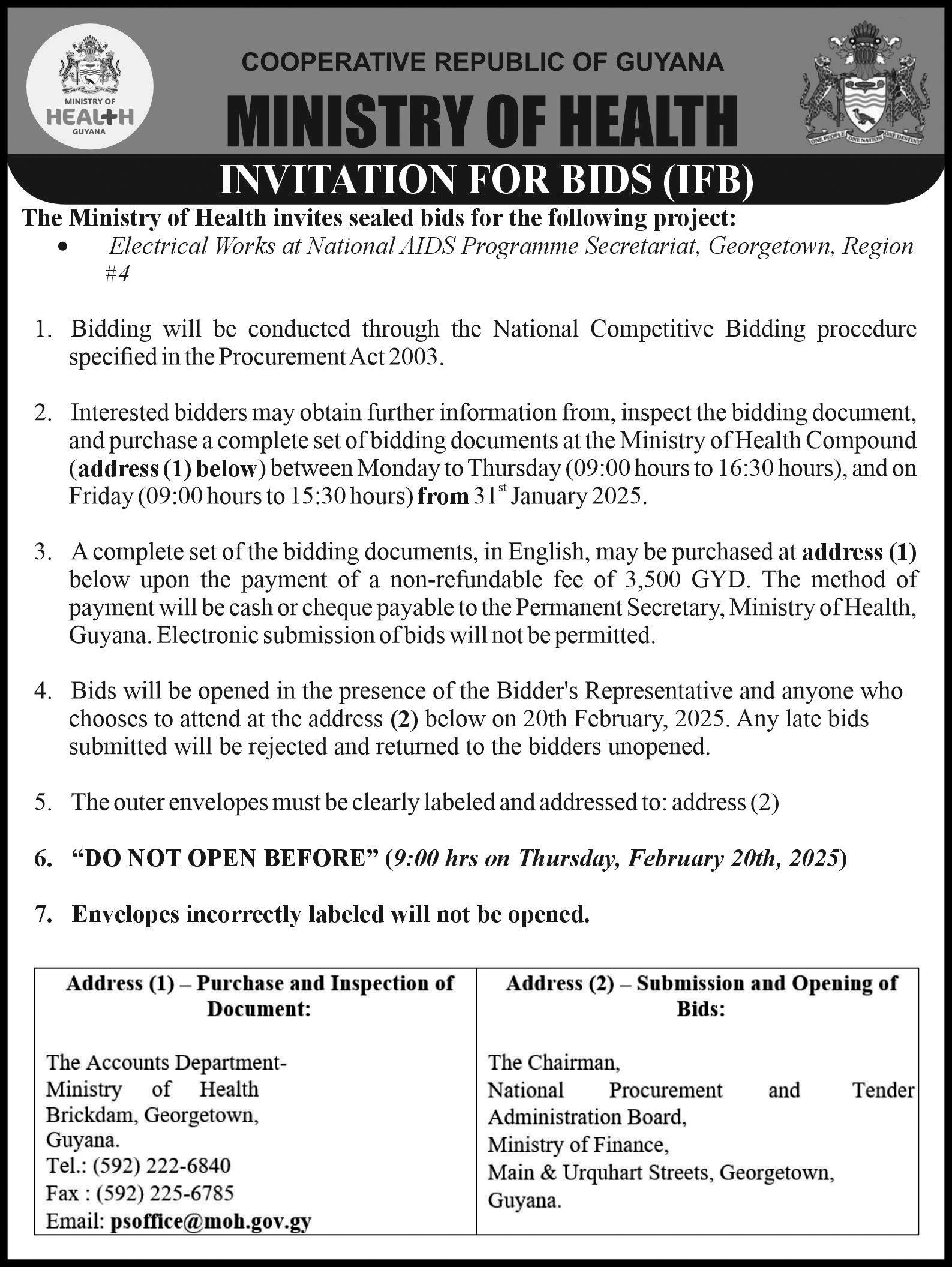
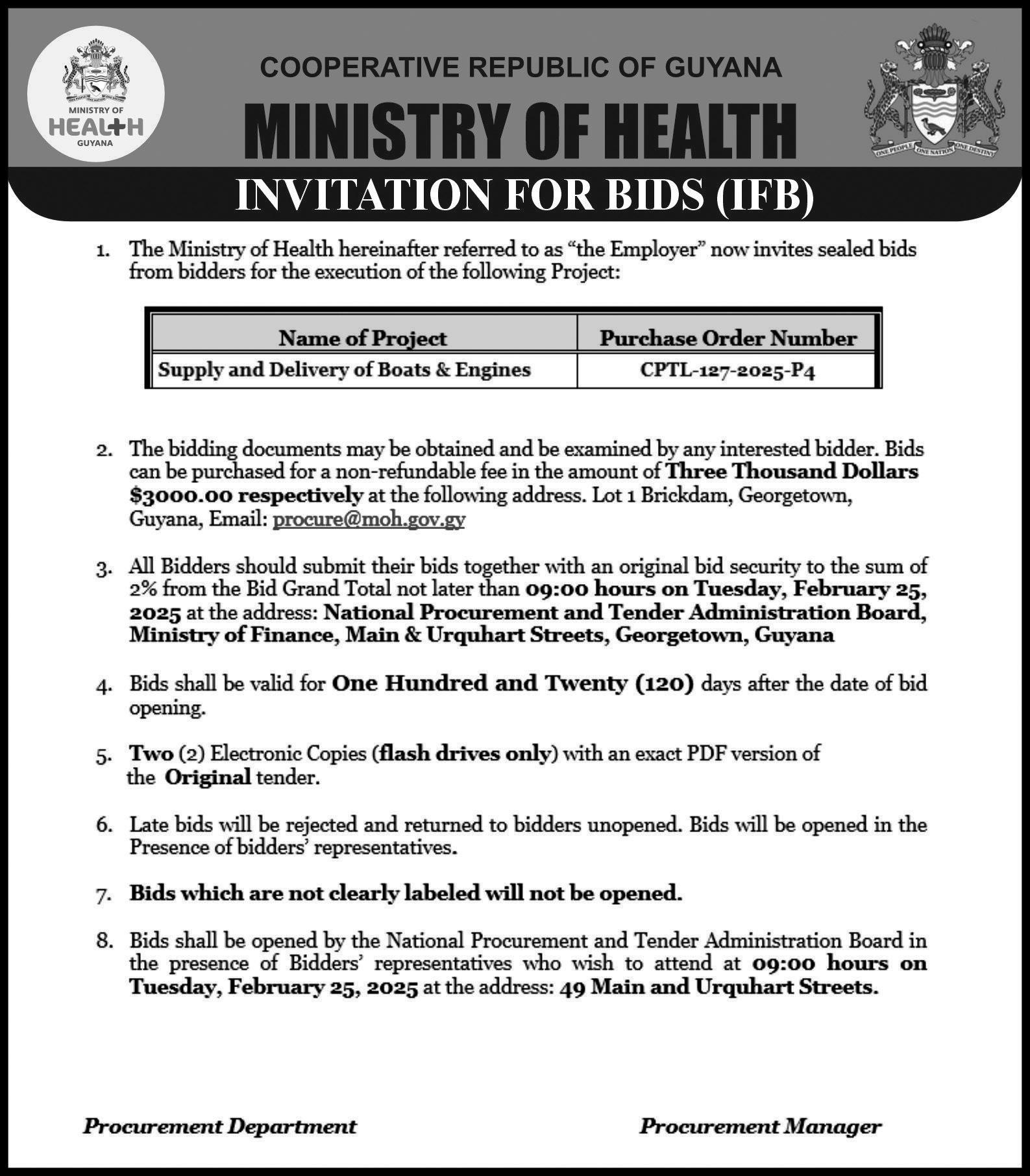
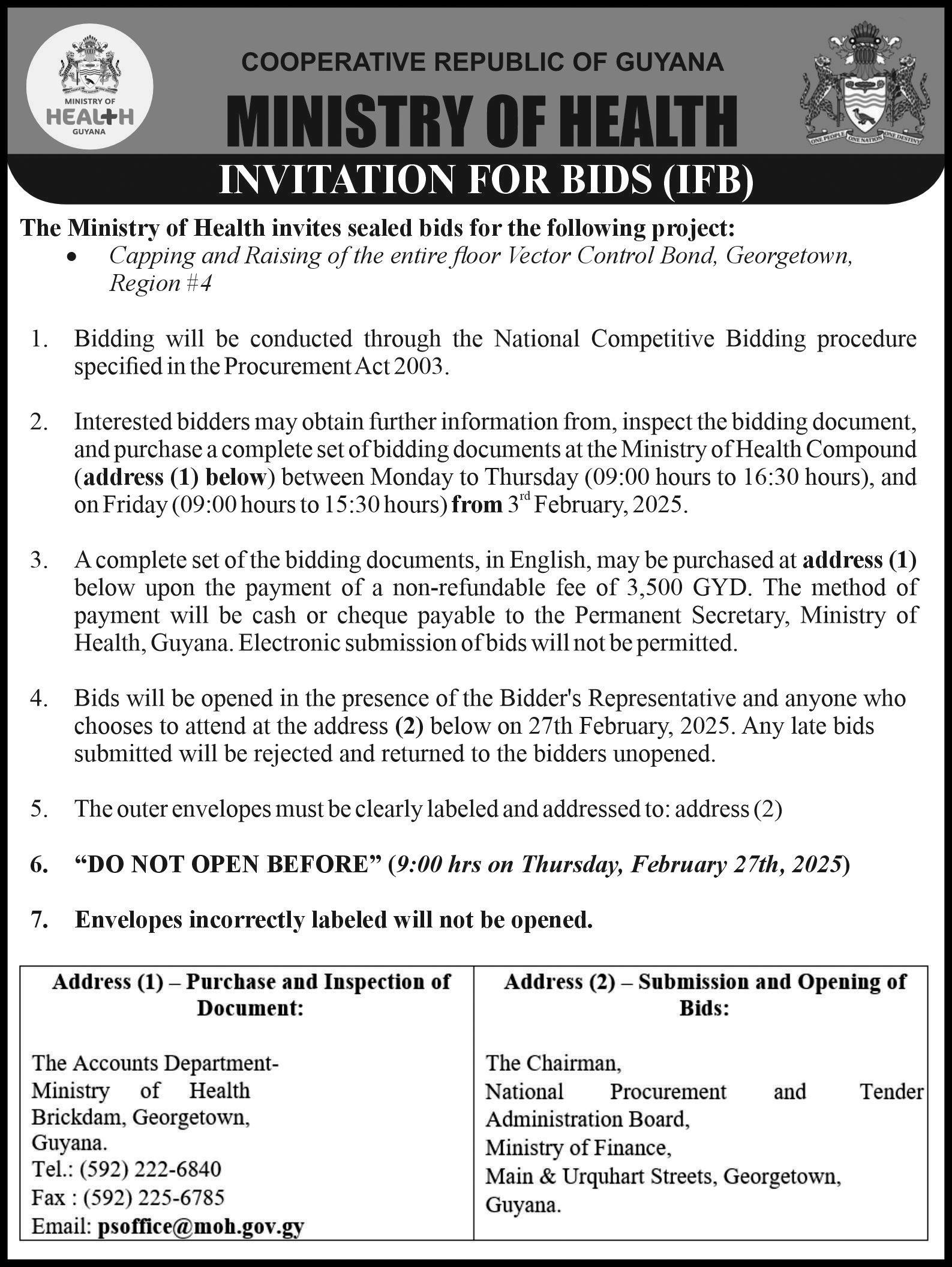

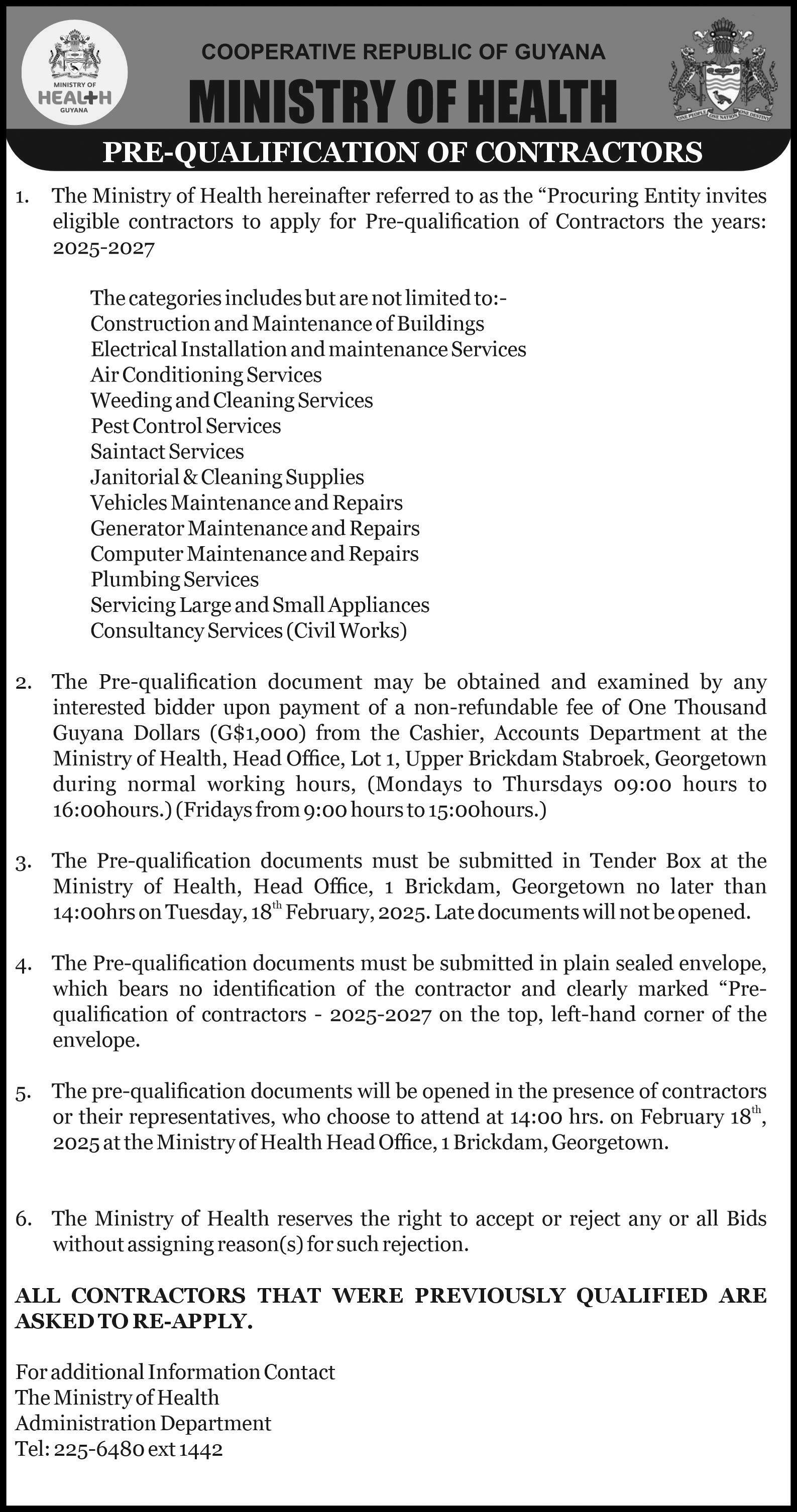
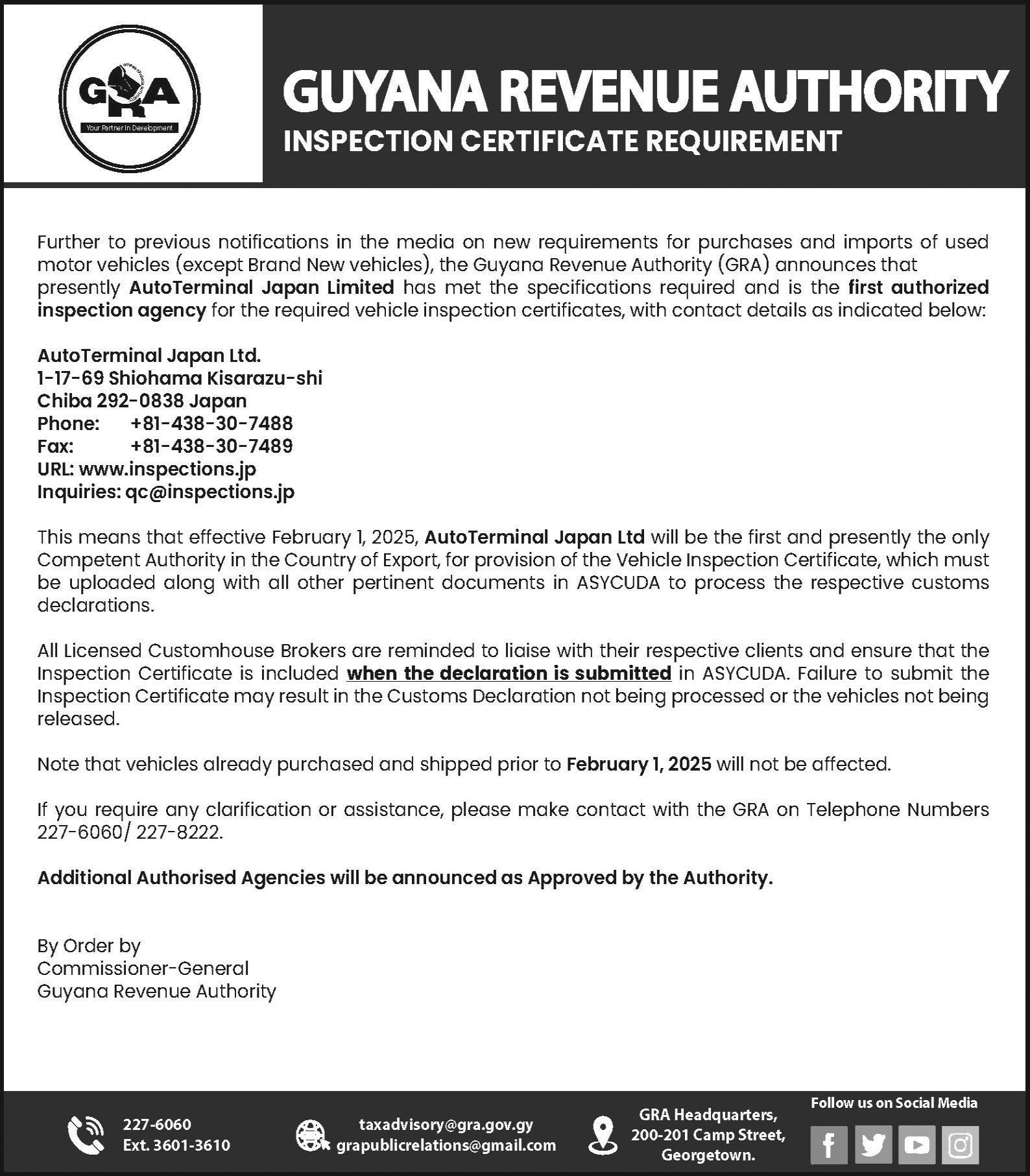
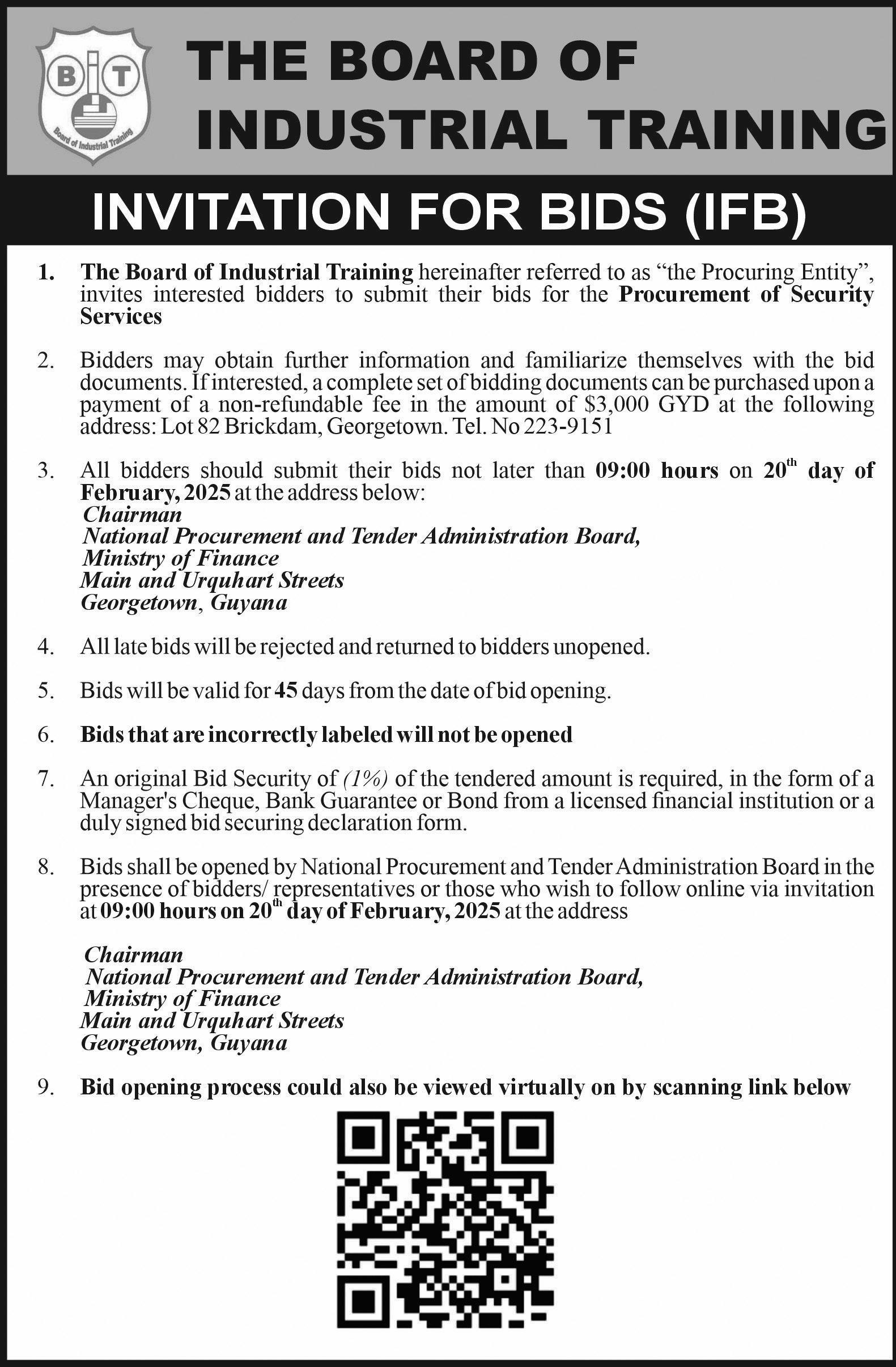

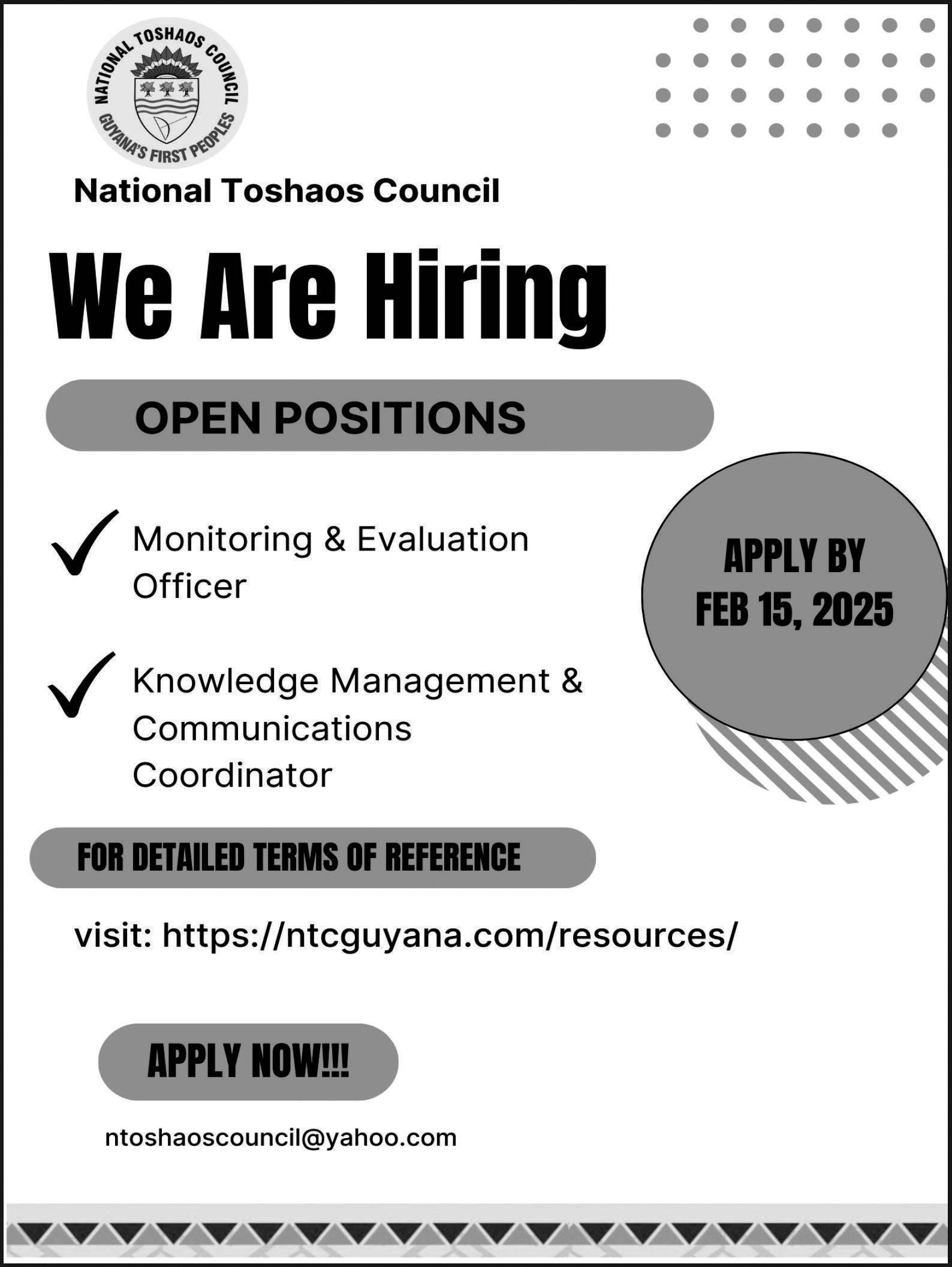

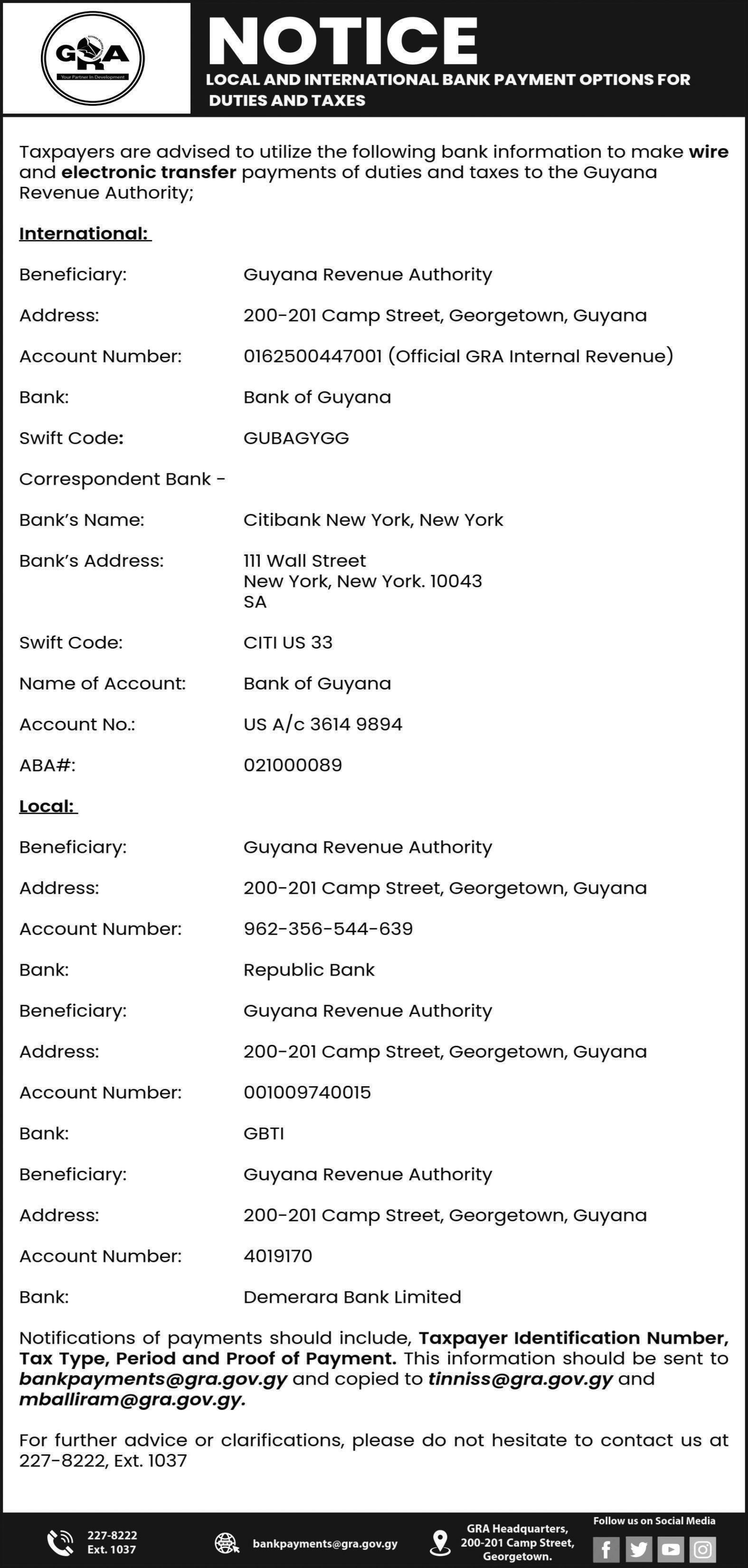

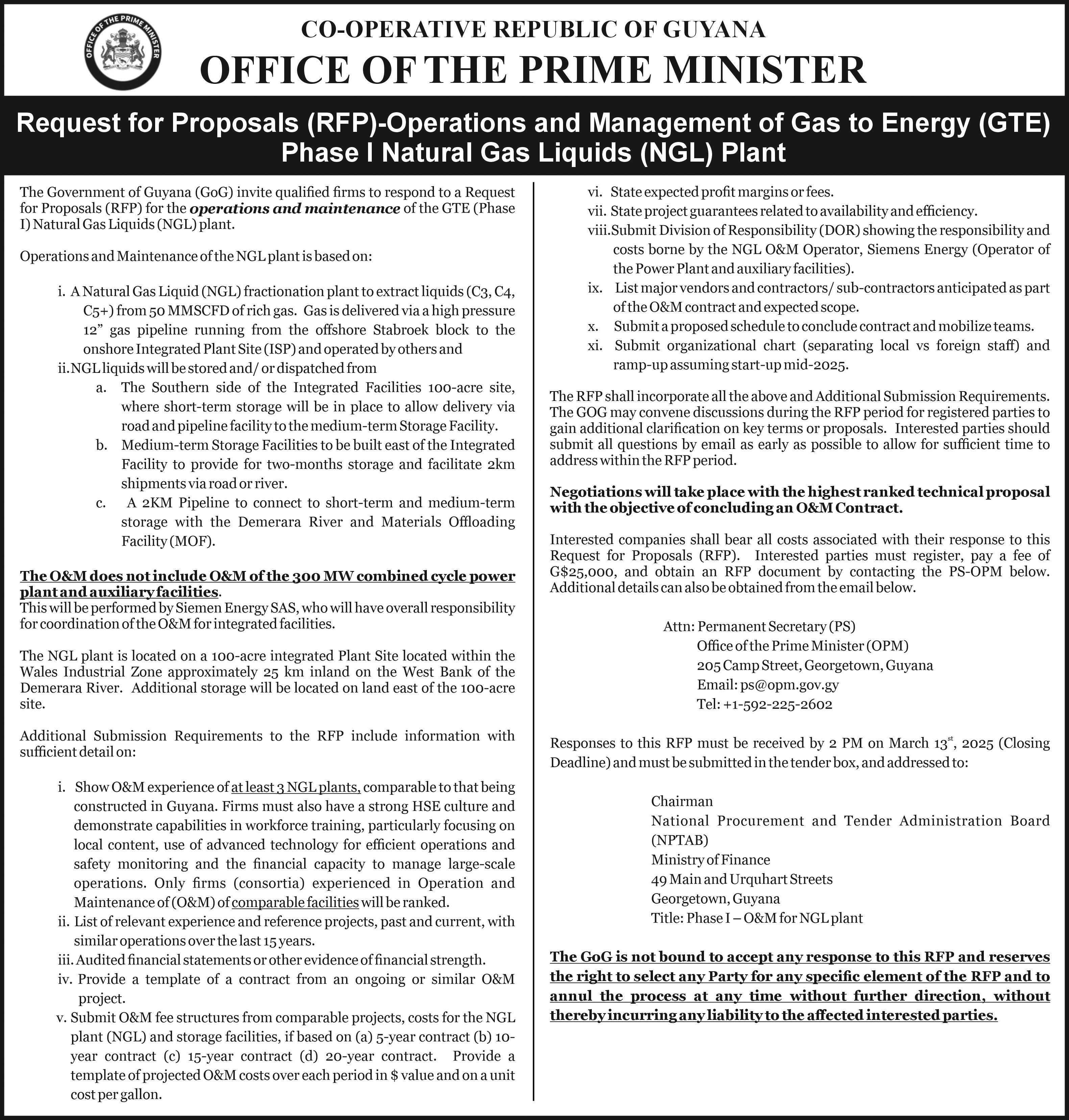

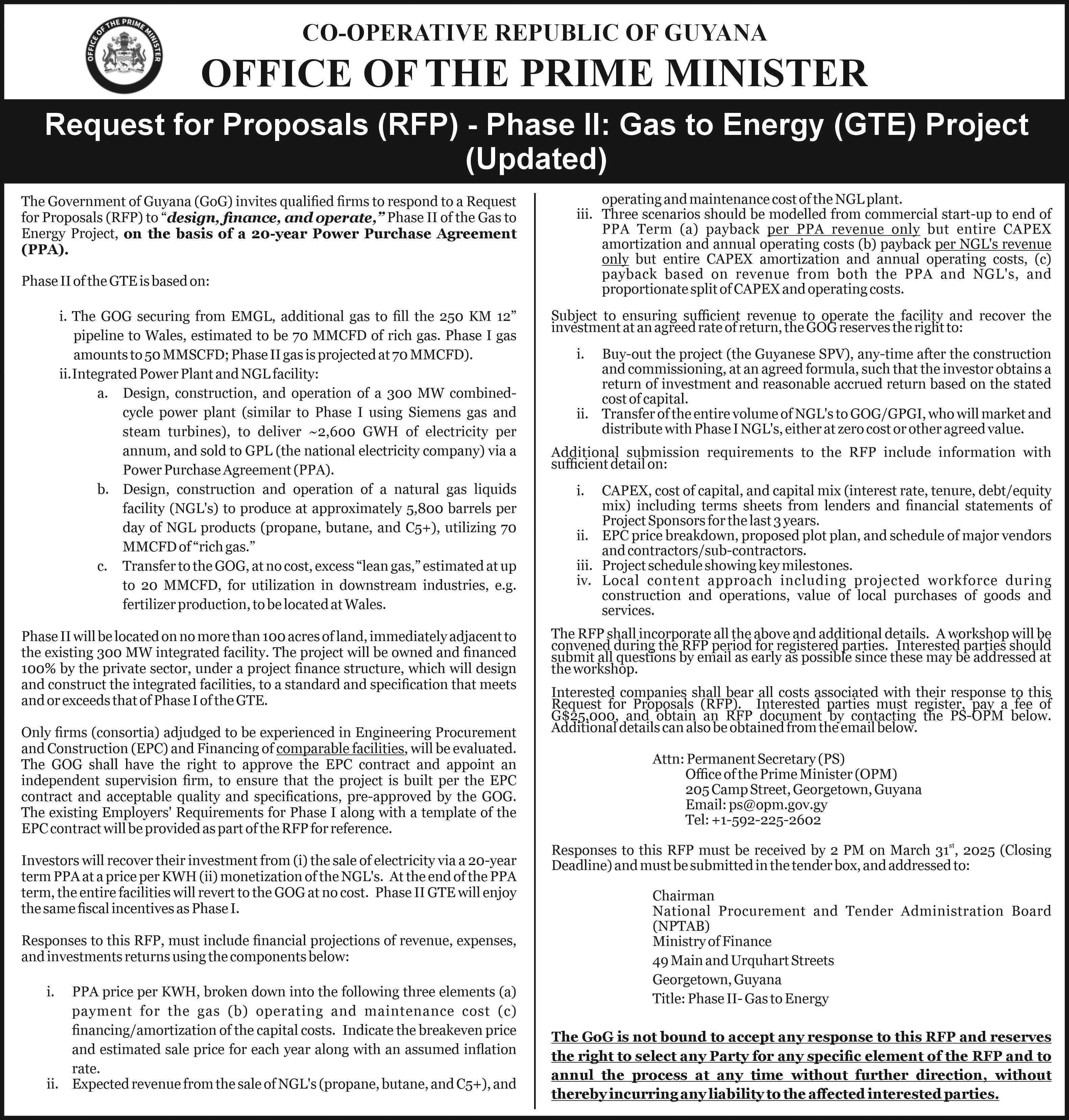



CAMILLE’ S Academy, home to over 1,500 students in Lusignan, Diamond, Soesdyke and Crane, Westside has announced a partnership with Nexgen Golf Academy that will see the schools having access to top-level training, equipment and facilities at Nexgen Golf Academy and Westside Golf Course.
Ms. Camille Deokie-Gorakh is an innovative leader in education and sees sport as a key development factor for young students.
She said, “Over the years, it’s been clear to me that our focus should be more than just academics if we want to produce the best rounded leaders of tomorrow. I have always been interested in golf but thought of it as a sport reserved for just a few elite until we met with Mr. Hussain who has changed the approach and access to golf in Guyana.”
Effective immediately, students will begin learning the basics of the sport and grade 10’s will commence preparation in anticipation for CSEC PE examinations in 2026.
Championship scheduled for July 2025.
Ms. Doekie-Gorakh touted the benefits of golf which allows students of all capabilities to participate.
“I’m impressed by Nex-
well. But more importantly, the networking opportunities that will be realised when our kids enter the job market are exceptional and coupled with scholarship opportunities to top universities worldwide,
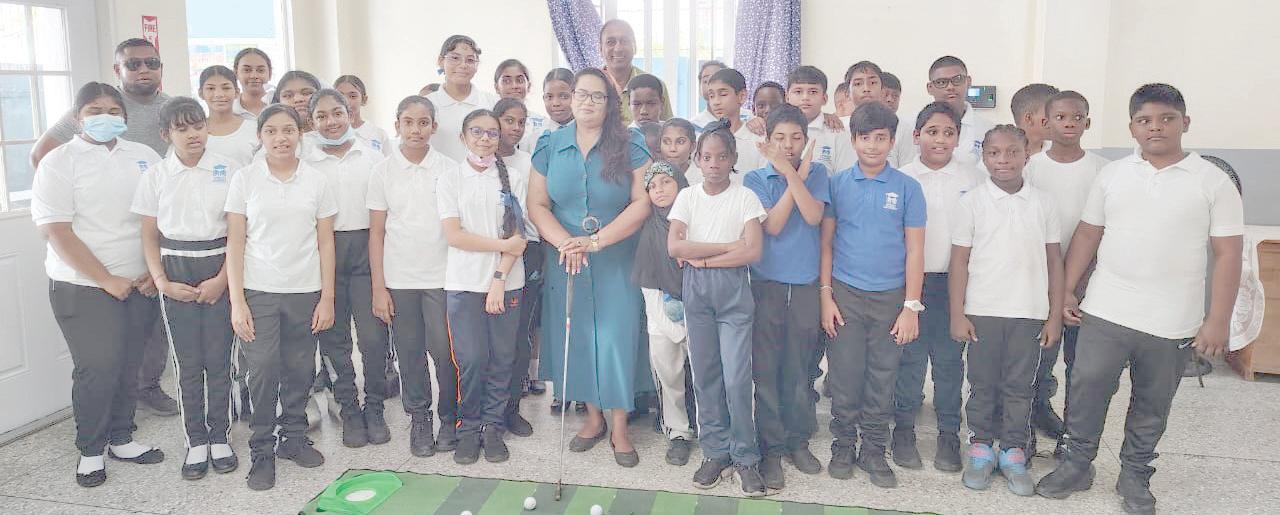
There are plans for several inter-classroom competitions leading to inter-school tournaments and participation in the National Junior Golf
Mr. Hafiz Ali, CEO of the Rockaway Group of Companies—home to the renowned Rockaway Roti Shop and Royal Empress Hall— once again opened his doors to host a farewell dinner for the Windies Masters as they prepared for their journey to the O50s World Cup in Colombo, Sri Lanka.
The Rockaway Roti Shop and Royal Empress Hall have gained a reputation as the go-to destination for authentic West Indian cuisine in the New York area, known for their exceptional quality offerings to both Caribbean and North American patrons. The farewell dinner was a delightful event, attended by 14 of the 17-member squad along with four directors from the Cricket West Indies Masters Association (CWIMA): Chairman Raj Singh, Vice Chairman Dave Narine, Zamin Amin, and Gerald Singh. Mr. and Mrs. Hafiz Ali were also present, along with several other supporters. Notably absent from the gathering were players Sudesh Dhaniram, Stephen Howell, and Surendra Seeraj.
The West Indies team finds themselves in the more challeng-
ing of the two pools, competing alongside Australia, Pakistan, India, South Africa, Wales, and Canada. They will kick off their campaign against South Africa on Sunday, followed by a match against India on Monday. All games will consist of 45 overs and utilise Duke balls. After a day of rest on Tuesday, the team will take on Canada and Pakistan on Wednesday and Thursday, respectively. Following a three-day break, they will face Australia and Wales the following Monday and Tuesday.
During the dinner, the Windies Masters expressed their gratitude to the Rockaway Group owners with a small token of appreciation—two West Indies polo shirts.
The complete West Indies squad includes: Zamin Amin (Captain), Ishwar Maraj, Terrance Romain, Sudesh Persaud, Surendra Seeraj, Anthony Sahadeo, Rajendra Sadeo, Fareed Hosein, Basil Persaud, Stephen Howell, Julian Boyce, Sudesh Dhaniram, Deonarine Deyal, Harry Narain Heeralall, Rajendra Dilraj, Kamraj Sumair, and Vejai Seonarine, with Raj Singh serving as the team manager.
WEDNESDAY, FEBRUARY 5, 2025
CUMMINGS ELECTRICAL COMPANY LTD-83 Garnett Street, Georgetown (Tel: 225-6158)
ANSWERS TO YESTERDAY’S QUIZ:
(1) Alick Athanaze-55 (First Test, Multan)
(2) Saud Shakeel-84 (First Test, Multan)
TODAY’S QUIZ:
(1) What were the best innings bowling figures by a WI in the recent Test series against PAK?
(2) What were the best innings bowling figures by a PAK bowler?
IN
gen Golf Academy’s approach which shows that everyone, regardless of speed, strength or height can take part and succeed in playing
we definitely want to proceed as quickly as possible.”
President of the Guyana Golf Association Aleem Hussain engaged with students
at the Crane and Lusignan facilities to introduce the sport and was pleased with the response.
“The reaction of young players who for the first time are given access to golf and find out that they can be good at it is the main reason we continue to push the development of the sport. The addition of Camille’s Academy is testament to the hard work our organisation has put into developing access to golf across Guyana over the past three years.”
The Westside Golf Course in Vreed-en-hoop is now available to everyone (no membership fees) along with the Nexgen Golf Academy on Woolford Avenue which is the only Lighted Golf facility in the country. Clubs, balls and coaches are provided for both experienced golfers and newcomers to the sport.
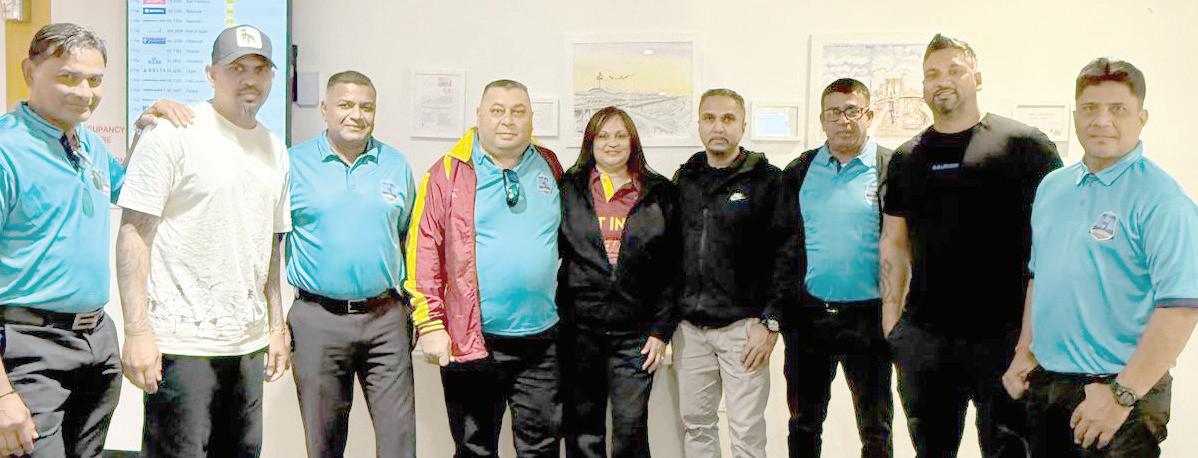
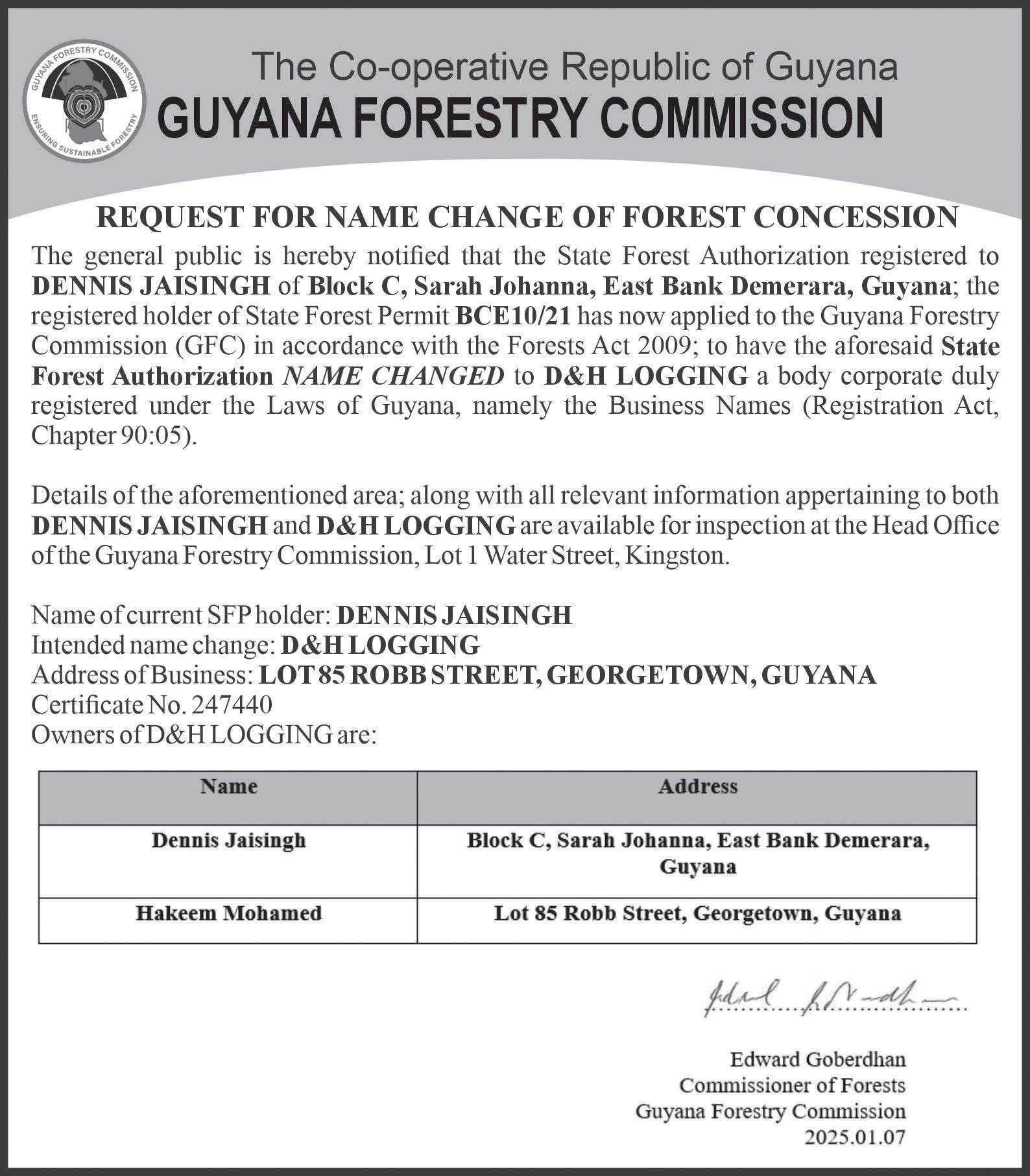
THE Guyana Cricket Board ( GCB ) has announced its upcoming Annual General Meeting ( AGM ) and elections for office bearers, set for Saturday, March 1, 2025. This notice was published in local newspapers on January 29, 2025
In March 2021, Bissoondyal Singh was elected unop-
posed as the GCB President, and as of now, no challengers have officially emerged to contest his position
There has also been no confirmation regarding Singh ’ s intention to seek re-election
Cricket Ombudsman Kamal Ramkarran oversaw the previous election process
However, since then, sev-
eral elected body members have resigned from their roles, and one member has passed away
Meanwhile , in a statement to the Trinidad Guardian on January 24 , 2025 , Singh noted that the membership voted to extend the presidential term from two to four years “ It is not me who ex -
PRESIDENT Dr. Irfaan Ali recently treated the National U-17 Boys’ football team (Junior Jaguars) on a memorable journey to the majestic Kaieteur Falls.
tended the tenure of office … it was the full membership, and it was passed unanimously,” Singh clarified . He added that the president and executives of the GCB do not vote unless they are also members of the county boards, emphasising that it was the three county boards that initiated the motion
THE Guyana Cricket Board and the Barbados Cricket Association have agreed to attend the Cricket West Indies (CWI) meeting next week for proposed resolutions to amend the Articles of Association.
Here is a full joint statement issued by both the GCB and BCA.
The Barbados Cricket Association (BCA) and Guyana Cricket Board (GCB) have agreed to attend the meeting of February 9, 2025 set by CWI to discuss the proposed resolutions to amend the Articles of Association despite their disappointment in the way in which the matter has been handled by CWI. The BCA and GCB have continuously added their voices to governance reform and at the last AGM tabled suggestions aimed at moving the matter forward.
We asked for further dialogue but, instead, our concerns were referred to the Integrity & Dispute Resolution Committee. The committee, chaired by a CWI Director, rejected our position.
It must be pointed out that no committee has the authority to overrule a request of a
representative of the shareholders and furthermore, any Ethics of Integrity Of Disputes Committee should be independent and should not be chaired by a sitting CWI Director.

Dr. Shallow chaired two forums just prior to the AGMs of 2023 and 2024 which allowed members to articulate their positions on various resolutions without having to vote thus allowing Shareholder Representatives to consider arguments (for and against) and report back
to their Territorial Boards prior to the Annual General Meeting (AGM). However, in this case CWI is not holding a discussion forum but is instead holding a Special Meeting to vote on the pro-
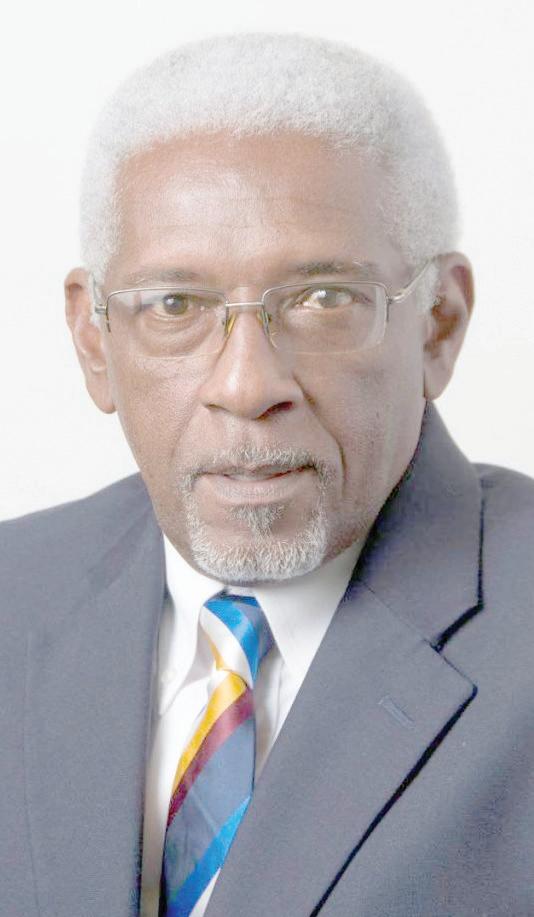
posed resolutions. Why are we being denied a forum which would allow us to ventilate what we consider to be fundamental to be the way forward for CWI? Why the indecent haste?
The narrative has also been sent that BCA and GCB are against governance re -
form. This is entirely misleading. We have voted in favour of most resolutions inclusive of some that are now revealing to be questionable. In light of no dialogue, BCA and GCB have written the CARICOM Secretary General setting out our concerns and proposed way forward as it relates to the items being tabled surrounding amendment of the section changing the tenure in office of the President and Vice President from two years to three years with term limits of three consecutive terms. It is hoped that this matter will be elevated at the next CARICOM Heads of Government meeting scheduled to take place February 19-21, 2025 in Barbados.
It was further disrespectful to the BCA and GCB that CWI Directors have publicly admonished us for not attending the last meeting despite our known position. In fact, it is unprofessional and a breach of the Code of Ethics.
The BCA and GCB will attend the CWI Special Meeting and make our submissions to be minuted and will exercise our vote accordingly.

The team, coaching staff, and Guyana Football Federation (GFF) members expressed gratitude for the President’s support.
The excursion was a special occasion for many players, marking their first visit to the iconic falls. It provided a welcome break for the team as they prepared for the Concacaf U17 Men’s Qualifier Campaign, allowing them to relax and enjoy a national treasure.
President Ali shared his sentiments in a Facebook post: “It was great having our under-17 national football team immersing themselves in the beauty of the mighty Kaieteur Falls.”
The Junior Jaguars are gearing up for the CONCACAF U17 World Cup Qualifiers, scheduled for February 7-16, 2025.

President Ali recently visited the team during their training camp at the National Training Centre in Providence and commended their enthusiasm and hard work. “When I speak to you today, I’m speaking on behalf of all of Guyana, all the people of Guyana. We have tremendous confidence in this team, which makes us proud,” he said.
He also pledged the government’s commitment to investing in players and sports facilities. The Junior Jaguars will compete in Group B against Trinidad and Tobago, the British Virgin Islands, Sint Maarten, and Costa Rica (the host nation).
They will participate in the FIFA U17 World Cup in Qatar from November 5 to 27 if they qualify.
President Ali reiterated the government’s plans to upgrade training facilities, stating, “We’re going to invest in further improving the facility, and we are also going to invest in you.”
Coach and Head of the Guyana Hockey Board , Phillip Fernandes, on Tuesday, announced the fixtures for the country ’s participation at the upcoming Pan American Hockey Federation (PAHF ) Junior Challenge.
Set for Bridgetown, Barbados from March 9 – 16 , according to Fernandes, the aim of the teams is to finish with gold or silver in both categories.
“Both our girls and boys have good opportunities at this upcoming tournament which features teams from the Caribbean and Central America and I think we are certainly competitive at that level. We do have the disadvantage of not being able to train on adequate surfaces for the tournament but we make up for that
with hard work, passion and extra effort to develop skills and tactics that take us to higher level and I think we will be very competitive,” Fernandes said
Guyana, ranked 36th in the world, will open the tournament on March 6 against Guatemala who they will meet for the first time.
The ladies then come
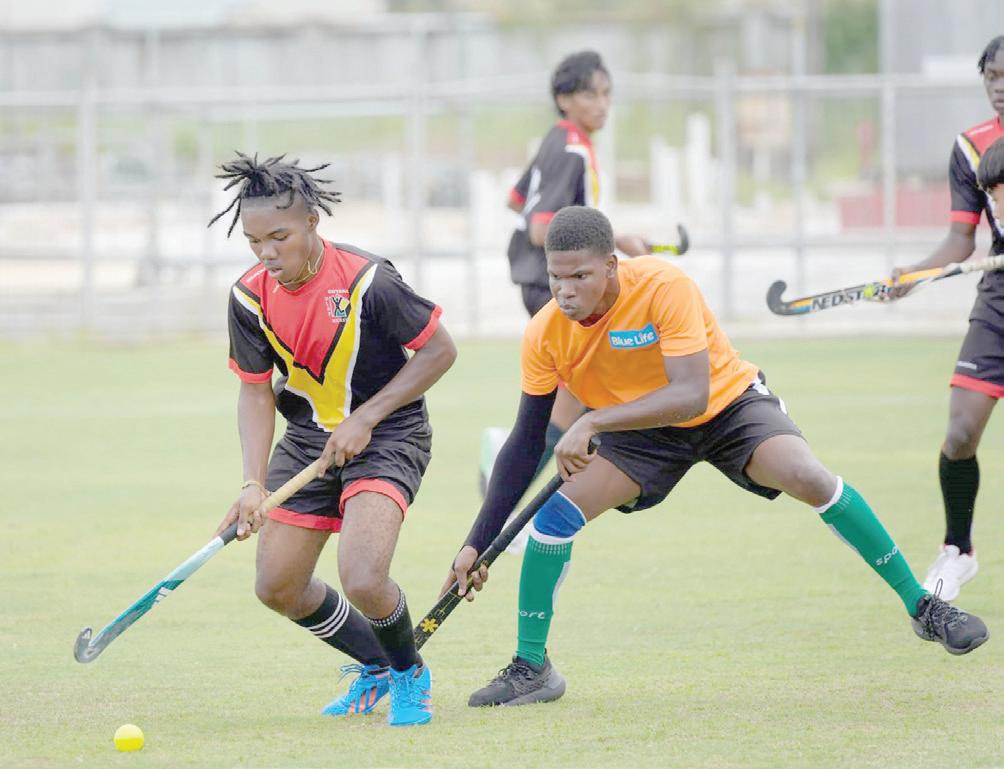
The girl’s class will feature hosts Barbados, Guyana, Trinidad & Tobago, Mexico, Guatemala and Puerto Rico.
up against Mexico the following day, with the latter ranked 40th with their next fixture on March 8 against Puerto Rico followed by
matches against hosts Barbados and Trinidad & Tobago.
The hosts are the highest seeded team in the competition with a world ranking of 33.
final squad which will be announced this week.
The GHB boss added, “As far as the training goes, I’m very excited by what I’m seeing, I think the clubs have
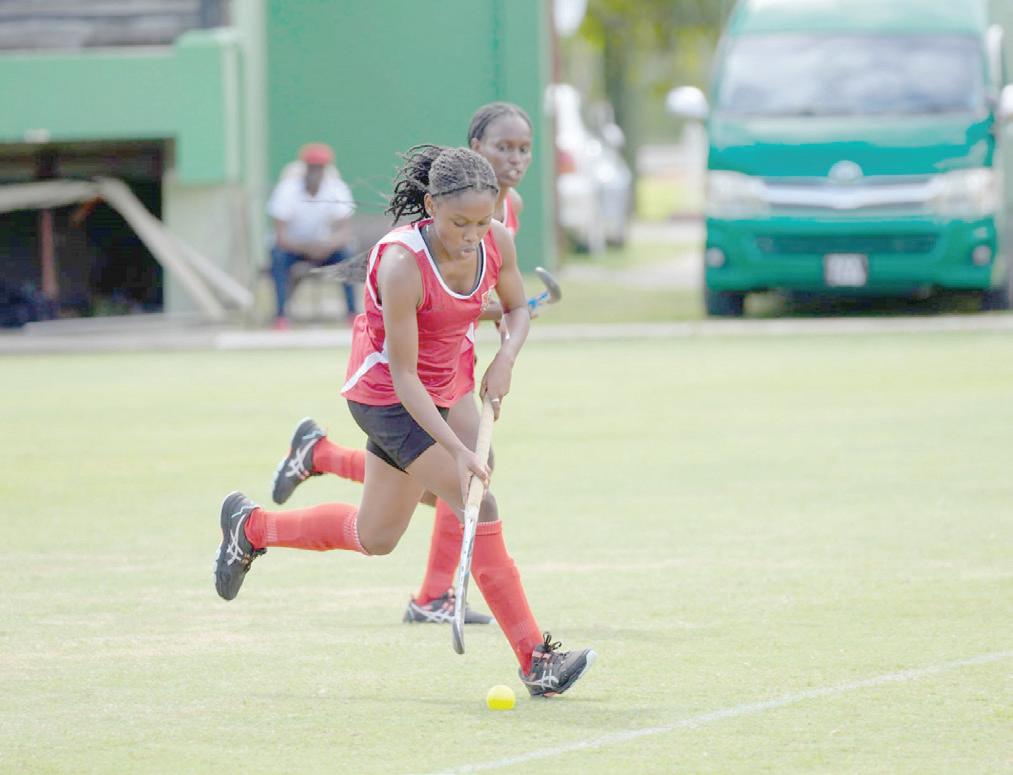
Fernandes who doubles as the women’s coach says competition for placement has seen players working harder to make it into the
done good work over the last two years in terms of developing players, so we are seeing a breed of new faces and players challenging for spots
and this is a welcome difference to some for the last teams that we had where we relied on particular stalwarts to carry the team forward. It is very competitive to make these teams now and we have choices that are proving to be very difficult.”
The men face Guatemala in their opening match followed by Trinidad & Tobago, Venezuela, Brazil and their final pool round game against Barbados.
Guyana can capture one of the top two spots remaining in each eightteam competition which will place them in the Junior Pan American Games.
The Challenge is the regional qualifier for the second ever Junior Pan American Games scheduled for 9th to 22nd August in Asuncion, Paraguay.
EVENT Operations Manager of ExxonMobil Global Super League Romario
Samaroo says that while they are cognisant of some unavoidable clashes with other leagues during the July period, this year’s event will be on a more grand scale.
“The way that cricket schedule has evolved, there will always be clashes, so finding a window that gives us a chance to be a lone event is almost impossible, however we are confident we won’t have any issue with finding teams and players to make this event even more successful than 2024,” he said.
The ExxonMobil Guyana Global Super League (GSL) 2025 has been confirmed to run from 8 to 18 July 2025.
The league which is an invitational competition is set to collide with an upcoming European T20 premier league and USA’s major league cricket, both of which runs around July and ends in August.
Samaroo says the body consulted to ensure they were no conflicts with the West Indies or domestic competitions.
“The window for the second GSL was decided upon after discussing with cricket West Indies which is the gov-
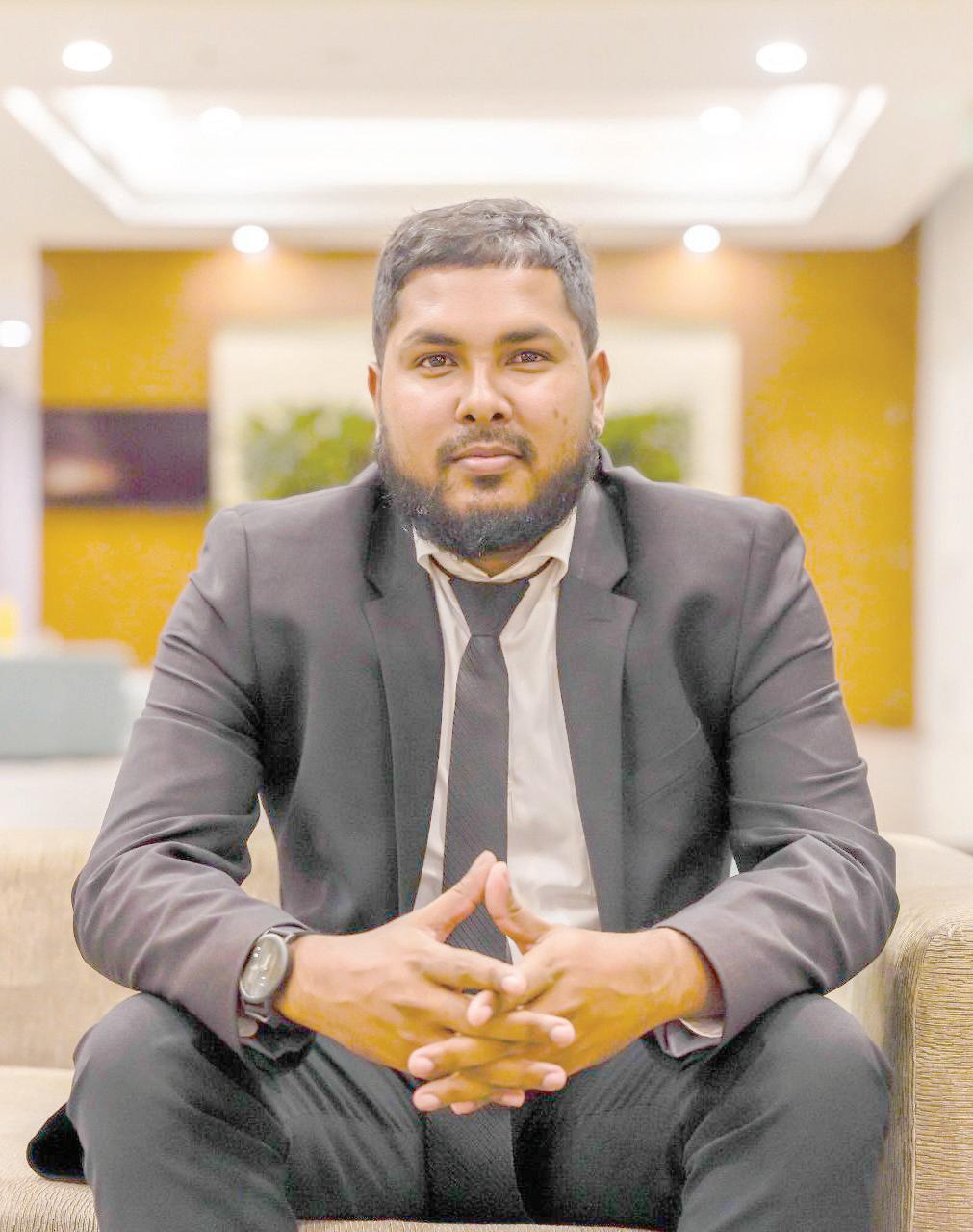
erning body for cricket in this region and the sanctioning authority for this event, these dates will give us a window clear of other cricket in the region which should help focus the attention on GSL.”
All 11 matches of the tournament will take place at the National Stadium, Providence with the t20 competition again featuring five
T20 teams battling for the diamond encrusted waterfall trophy.
The inaugural competition, a brainchild of his excellency president Mohammad Irfaan Ali and chaired by legendary West Indies World Cup winning captain Clive Lloyd hosted five teams over two weeks of action last year.
The teams came from
five top leagues around the globe namely Guyana Amazon Warriors, Lahore Qualanders, Hampshire Hawks, Rangpur Riders and Cricket Victoria.
The inaugural final was won by the Rangpur Riders of the Bangladesh Premier League, which defeated Australia’s Cricket Victoria in the final.



CONSTRUCTION of a new multipurpose stadium at Palmyra, in Region Six, is advancing quickly, according to President Dr. Irfaan Ali in a recent Facebook post.
The 10,000-capacity facility began construction in March 2023 and is designed to meet International Cricket Council (ICC) standards. It can also accommodate other sports, concerts, and large events.
While the total project cost has not been publicly disclosed, oil company ExxonMobil has pledged $3.7 billion as part of its $20 billion “Greater Guyana” initiative. Owen Steel Company Inc. and Caribbean Green Building Inc. are handling construction.
Minister Charles Ramson Jr recently stated the government’s commitment to opening at least five new stadiums in 2025, including the one at Palmyra. Other locations include Mackenzie, Bayroc, New Amsterdam, and Anna Regina.
The government also plans to upgrade numerous community grounds nationwide.
rapidly’
